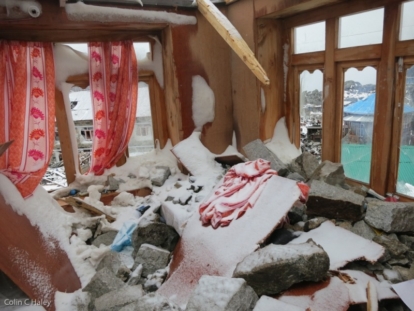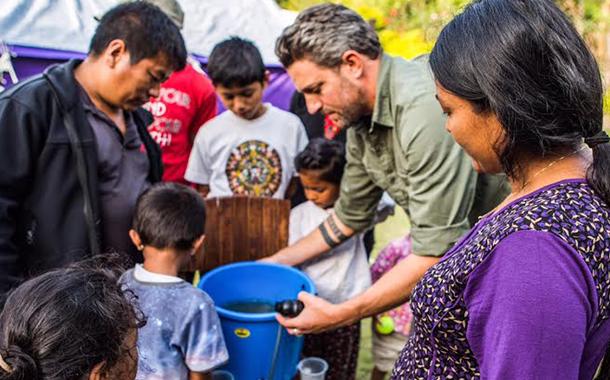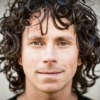Colin Haley on the Earthquake in the Langtang Valley
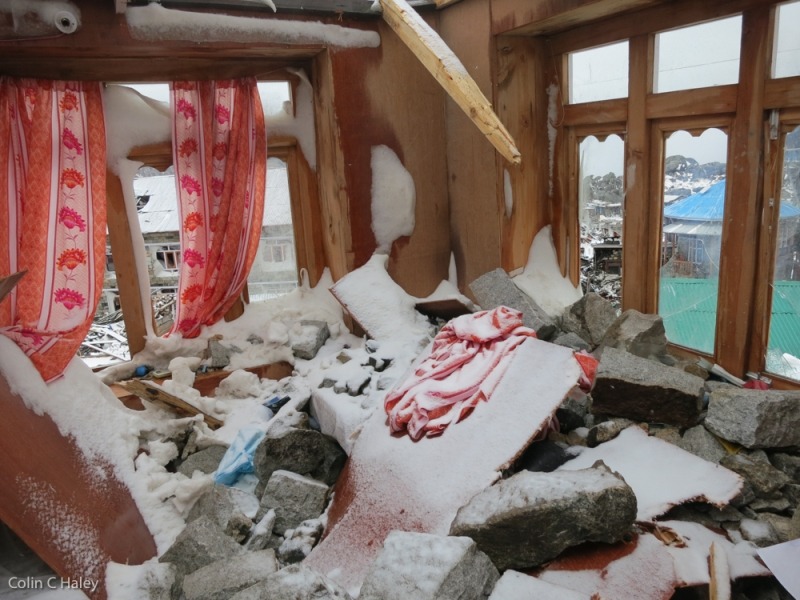
I got on a plane in Vancouver around midday on April 16. I was exhausted. After a four-month season in Patagonia, my six weeks back in North America turned out much less restful than I had imagined. Conditions had been excellent, and I couldn’t keep myself from going out in the mountains a bunch. The downside to my most successful ever season in Patagonia is that I was swamped with requests for photos, requests for writing, and a huge pile of related e-mails. I barely slept my last couple nights in BC, staying up late trying to catch up, and then finally closed my computer to head to the airport. I hadn’t caught up—not even close—but I was out of time. I finally just forced myself to let it go: “No one’s gonna die because you didn’t reply. It’s only e-mail.”
Editor’s note: Our hearts go out to all who were impacted by the recent earthquakes in Nepal. You can find ways to help at the end of this post. We’re grateful to Colin for allowing us to share this story which first appeared on his personal blog, and we’re so glad he’s home safe.
After a couple hours in the airport in Guangzhou, I boarded a plane for Kathmandu. In the last few days I had put in a lot of time to make sure I had all the necessary equipment packed, but beyond gear I don’t think I’ve ever started a climbing trip so clueless and unprepared. I’d never been to Nepal before, and knew almost nothing about it. I borrowed the Lonely Planet guidebook from some young Australian guys next to me on the plane, and did some last-minute studying. Around midnight on the 17th, I arrived at the house of Raphaelle, a young woman who is half Nepali and half French. My climbing partner, Aymeric Clouet, had arrived from France early that morning, and he stayed up to greet me.
My first morning in Nepal was spent brushing off my rusty skills in speaking French, sharing bread, mangoes and delicious Nepali bananas (they have way more flavour than the bananas we get in North America) with Aymeric, Aymeric’s wife Pauline, their daughter Margeaux, Raphaelle, and a couple other French friends of Raphaelle who were living in Kathmandu. As unbelievable as it must sound after the fact, the topic of breakfast conversation was earthquakes. Pauline talked of how, according to seismologists, Nepal was long overdue for a big earthquake, and that she worries about it on every trip. In hindsight it was quite the foreboding, but the mangoes were finished, and Aymeric and I took off to find a taxi, and take care of some Logistics in Kathmandu.
On the 19th we took a jeep from Kathmandu to Syabrubesi, a village in Rasuwa District, which is also the trailhead for heading into the Langtang valley. On the outskirts of Kathmandu we picked up Pinju, a kind and shy Nepali man who Pauline had worked with many times in the past (she works often as a trekking guide in Nepal, and speaks Nepali), and who Pauline had hired to come along with us and carry Margeux. Margeaux, at only two-and-a-half years old, didn’t have enough endurance to hike all day long. Upon arriving in Syabrubesi, Aymeric was immediately hailed down by Gualboo. Gualboo runs a lodge in Kyanjin Gompa, and Aymeric, a mountain guide by profession, had stayed in his lodge last year while climbing in the Langtang valley with a client. Gualboo had hiked down to buy some supplies in Syabrubesi and greet us. He was clearly excited to see Aymeric, and I think equally excited for the tourist season. He had built his lodge just two years ago, and it would be his second season in business.
On the 20th we were finally walking, and I was glad. I was happy to be done sitting on planes and cars, done breathing the pollution of combustion engines, and finally getting my blood flowing a bit. I couldn’t help but make comparisons to Pakistan, the only other place I’ve climbed in the Himalaya. For one, the lush temperate jungle that we hiked through was a pleasant contrast to Pakistan’s arid, dusty valleys. I was blown away by the degree of development in the Nepali mountains. River crossings that in Pakistan would surely be a few logs tied together were instead massive suspension bridges, built from steel and concrete. While in Pakistan one would truly be camping during the approach to a mountain, here we were hiking through numerous villages. The lodges had solar panels and electricity, wood stoves, glass windows with curtains, and even showers. In the evening we watched monkeys in the trees, ate our share of dal bhat (the standard Nepali meal of rice and lentils) and slept in a guest house in Lama Hotel (that is actually the name of the entire village).
On the 21st Aymeric, Gualboo and I temporarily parted ways with Pauline, Margeaux and Pinju. While the three of us hiked directly to Kyanjin Gompa, the highest village in the valley at 3,860 meters, Pauline decided to spend a couple more days on the approach, wanting to play it safe with Margeaux’s acclimatization. Along the way I got to know Gualboo a bit, and learned about the valley from him. He has lived his entire life in the Langtang Valley, and told us that this past winter had by far the biggest snowfalls he’s ever seen. Well over a hundred yaks died in avalanches during the winter, and a couple times during the winter he had to exit his lodge from a window, walk around and dig out the door. Passing through Langtang, the largest village in the valley, we saw homes with the windows blasted out and the up-hill sides still plastered with snow, from the last major avalanche to hit the village, just two or three weeks earlier. Another foreboding. The upside to such an unusually large snowpack is that Aymeric had fortunately heard about it a few days before we departed for Nepal, and after some last-minute gear rearrangements, we had come with ski touring equipment.
We stopped in Langtang village for lunch, and Gualboo chatted with friends. Although he now lives in Kyanjin Gompa with his immediate family, and runs his lodge, Holyland Guesthouse, there, he grew up in Langtang. We stopped by a dairy farm to buy a kilo of yak cheese, and on our way out of town stopped so that Gualboo could chat with his father. For the last few kilometers to Kyanjin Gompa I felt my lack of acclimatization, and walked very slowly to avoid getting an altitude headache. As soon as we arrived in Kyanjin Gompa we were greeted by Gualboo’s brother-in-law, Sunu, and before too long we were drinking tea in the “dining room” of Gualboo’s guesthouse, and introduced to Gualboo’s wife, Lopsang. Gualboo’s three beautiful and shy daughters, aged 9, 11 and 13 I believe, hung out with us and giggled as I struggled to properly pronounce their names. They were due to depart in about a week for school in Dunche. Gualboo’s son was already in school in Kathmandu.
On the 22nd we took it easy and let our bodies adjust to the altitude, just going for a little walk, organizing our things and packing some some ski gear for the next day. We woke up at dawn on the 23rd, crossed the river (on a big, nice bridge), and started booting up a north-facing couloir. Our excursion took us, at a very mellow pace, up to a little sub-summit at 4,900m, with nice views of Lantang Lirung, the 7,200m beast across the valley, immediately above the villages of Kyanjin Gompa and Langtang. The snow had softened a bit too much by the time we started our descent, but it was still really fun spring skiing. Far too soon we were gasping, smiling and clicking out from our bindings at the end of the snow, barely above the valley floor. I told Aymeric it was the most fun first day of acclimatization I’d ever spent, and we were both already very happy to have brought skis with us. As is usual for me, on the descent I’d forgotten all about high-altitude pacing, and although I had gone up to 4,900m with no problems I now had an altitude headache. We slowly walked back to Gualboo’s lodge, and found Pauline, Pinju and Margeaux, who had just arrived. While I spent the afternoon nursing my headache, two-and-a-half-year-old Margeaux ran around gleefully, clearly feeling the altitude less than the rest of us.
On the 24th we took it easy, and just went for a short hike up-valley with Pauline, Margeaux and Pinju. On the 25th Aymeric and I woke up at dawn, crossed the river, and started booting uphill with our skis again. The day was grey and misty, with the whole valley socked in clouds, but we figured a bit of elevation gain would be good for acclimatization, even if the weather prevented going to the roughly 5,200m col we aimed for. By the time we’d arrived at 4,500m the visibility had only worsened, so we ripped our skins and had another fun ski down to the valley. We were back at Gualboo’s lodge before most people had even woken up. We sat outside for a bit eating bread and yak cheese, and were back in our cozy sleeping bags by about 9am.
I woke up from my nap at what must have been about 11:40, put on a jacket and my shoes, and went downstairs. Aymeric, Pauline and Margeaux had already ordered some lunch, and we hung out in the dining room. When the shaking started, it only took us a second or two to realize what was going on, probably in thanks partly to our conversation that first morning in Kathmandu. We ran out of the lodge before anything starting falling, Aymeric with Margeaux in his arms.
People were darting out of buildings all around us, and at first we all just stood in the open spaces between buildings and watched as they began to fall apart. Although a few of the newest buildings were built better, most of the buildings in Kyanjin Gompa were made basically of just very carefully stacked granite blocks, with the bare minimum of cement in between, if any at all. The buildings came apart very easily, and all around us blocks of granite were falling to the ground. My instinct was to get out of the village, away from the collapsing buildings, and obviously I wasn’t the only one thinking that way, because it seemed like everyone started pretty simultaneously walking and running towards the grassy meadow plateau at the east end of the village.
I was just about free of the last buildings, almost into the grassy meadow, when I glanced back and saw the avalanche. No one had heard it beforehand, because there was so much noise of collapsing buildings and people screaming. No one saw it beforehand because of the thick cloud ceiling not far above the village. I saw a humongous cloud of snow descending through the cloud layer and down-valley towards us (coming from the basin immediately uphill, at the base of the east face of Lantang Lirung). I have seen plenty of big avalanches in Alaska and Pakistan, and none of them were anything like this. The avalanche that was coming down through the clouds and across the moraine seemed to be 300-400m tall. It was merely the powder cloud, the actual debris of ice and rock having stopped on the uphill side of the moraine, but was moving much faster than I’ve usually seen in powder clouds.
I think I was one of the first people to see the avalanche coming down out of clouds. I pointed and yelled, and because I was in the mode of speaking in French and thinking in French, “Regarde!” is what came out without thinking. Almost no one around me spoke French, but people turned to see, and within a moment everyone was screaming and running. At this point I lost track of where Pauline went, or where Aymeric went with Margeaux. I simply started running as fast as I could across the meadow, away from the direction the avalanche was coming.
The avalanche was upon me about halfway across the meadow, and I crouched down on my hands and knees. At first I wasn’t terrified. I’ve been in many other powder clouds, where tents get blown around a bit, and snow gets packed into crannies, and although I knew this one was much bigger, I optimistically thought it might be a similar experience. The wind was incredibly thick with snow, and I pulled my hood down past my face, creating a little pocket in which to breath. Within a few seconds there was so much snow in the air that it blocked out all light. Seriously, it went pitch dark. I could feel snow accumulating around me. Now I was scared. Although it had been windy since the moment the powder cloud was upon me, it now started to get much stronger, and despite desperately trying to stay in place, I started to get pushed across the meadow, still crouched on my hands and knees. I had only been pushed for a couple seconds and a few meters when the real blast hit. I guess it could be described as a pressure wave. I was hit by an incredibly powerful blast of wind, completely in another league from the worst winds I’ve ever seen in Patagonia, and in an instant I was airborne. Now I was truly terrified. In scenarios like this your body goes completely limp. I was just rag-dolling through space, and it felt very violent. I definitely thought, “OK, this is it. This is the avalanche I die in.” It’s really hard to know, but I estimate that I was blown a horizontal distance of about 30-40 meters. The meadow is a sort of plateau, and I was blown off the edge. I landed partway down the bushy and grassy slope below, now covered in snow, and slid the rest of the way to the valley floor. I ended up with all sorts of bruises, cuts and injured muscles for which I of course have no specific recollection of the impact. The only impact I distinctly remember is hitting the ground with my head, very hard, but luckily not on a rock.
At the base of the hill I had barely come to a stop, from the most violent “fall” of my life, but I immediately stood up and started running. I was terrified that more avalanches might be coming behind, or that the debris was still on its way. Within a hundred meters my run slowed to a brisk walk, and I followed the tracks of a yak that was clearly bleeding profusely. At what seemed roughly to be the middle of the valley floor, I stopped to look around. A Nepali man stopped beside me. For a couple minutes we stood staring at each other, hyperventilating and trembling, with neither of us even trying to say a thing. I shook out my hair, which was matted with about 10cm of snow. I shook the snow out of my clothes, and shook the snow out of my shoes, which had miraculously stayed on my feet. I could tell immediately that I had hurt my neck, but my body seemed to be working fine. Some people appeared atop the hill, at the edge of the meadow, yelling and gesturing for us to come. The Nepali man started walking back towards the village, but I was still too afraid to head in the direction the avalanche had come from. Within the span of about a minute, the entire wide, grassy valley had accumulated about 20-30cm of snow, so even though we were “only” hit with the powder cloud, there was clearly a lot of snow in it. In every direction there was enough steep relief that I could easily imagine more huge avalanches coming down. No spot seemed safe. I hadn’t yet explored enough up-valley to know if there were any big lakes. I realized that by standing on the floor of the valley I was in the path of any big lahars that might come down, and with some reluctance started walking back towards the village.
Partway back up the hill, I saw Aymeric look down from the edge of the meadow, and he ran down to me. His face was blasted with dirt. When he arrived his first, gasped word was just “Putain!” but he quickly followed with “Ça-va?” “Oui…” I said, “…je pense. J’ai mail au cou.” I wasn’t really sure I was OK, but I at least seemed to be OK enough. Aymeric gestured to me to help carry two injured Nepali men up the hill. I think that about six other people were blown off the meadow in the powder blast like I was, and not all of them were so lucky to miss the rocks. One Nepali man was bleeding significantly from his head. Another Nepali man seemed to have an injured back and couldn’t walk. A Korean woman broke her leg.
At the edge of the village I regrouped with Aymeric, Pauline and Margeaux. When they saw the avalanche they had wisely chosen to hide behind some stone walls rather than try to run. Thus they had been blasted with snow and wind, but protected enough to stay safely in place. If Aymeric had been crouched out in the meadow with me when the wind blast hit it’s hard to imagine Margeaux making it through alright. We started scheming what our course of action should be.
The village had been hit by a double-whammy of sorts. When the earthquake hit the stone buildings fared poorly, but wooden structures did pretty well. What was left of the stone structures fared well in the avalanche, but less-dense materials were flattened or blown away by the avalanche. Down in the valley floor lay pieces of corrugated metal, pieces of plywood, and other detritus. I was lucky that none of those building materials had hit me in the air. Many of the roofs had been blown off the buildings. The village helicopter pad had been encircled by a barb-wire fence. Despite the fact that a barb-wire fence has almost no wind resistance, every single thick, steel post had been bent flat to the ground.
Using some corrugated metal and other building materials now lying on the ground, Aymeric got to work on making us a bivouac against the side of a boulder. We were too afraid to take shelter in what was left of the buildings, for fear of aftershocks, and we wanted to be on the downhill side of a boulder for fear of avalanches. Although we didn’t want to go back into Gualboo’s lodge, we were now in the Himalaya with just the clothes we had been wearing inside, and starting what we imagined could be a prolonged “survival situation.” Aymeric and I took turns dashing into Gualboo’s lodge to collect what we could, while the other person waited outside, ready to yell at the first sign of an aftershock. The inside of the lodge was partially filled with snow, and partially filled with broken wood and granite blocks from the collapsed ceiling. We luckily had been storing a lot of our gear in a sort of closet, as our bedroom was particularly filled in with debris. We grabbed sleeping bags, foam pads, boots, gloves, clothes, a stove, some food, headlamps, the satellite phone, and took them back to the bivouac shelter on the edge of the village.
I didn’t realize it during the chaos of the moment, but immediately after the avalanche many people, including both foreign trekkers and non-local Nepali (Nepali who don’t live in Kyanjin Gompa), grabbed their belongings and started hiking down-valley from Kyanjin Gompa. We had no idea how many aftershocks might come, and how many more avalanches might be triggered, but neither Aymeric nor I thought we would be any safer down-valley than in Kyanjin Gompa, and in hindsight I’d say we were right. I think that in an emergency situation a lot of people have an instinct to “get out” and head straight back to wherever they came from, without necessarily assessing if it is the wisest choice of action.
Gualboo, Lopsang and their daughters were all fine, although I don’t know where they took shelter during the avalanche. Pinju had taken shelter in Gualboo’s kitchen during the avalanche, which is a separate building from the lodge and fared well in the earthquake because it was built almost entirely from wood, and fared well in the avalanche because it was immediately in the lee of the two-story lodge. I think it was just a few hours after the avalanche, although it could’ve been the following day, when the first people returned to Kyanjin Gompa after hiking down to Langtang. I was chatting with Gualboo outside his lodge when the news arrived, and it’s a moment I’m not likely to forget anytime soon. Langtang had been completely obliterated by the debris of an enormous avalanche, and only about a dozen people survived, out of three or four hundred. Gualboo’s home had already been destroyed, and therefore also his profession upended. Now he and Lopsang learned that their parents, their grandparents, their cousins, their aunts and uncles, their friends… had all died. Gualboo and Lopsang wailed, and their daughters burst into tears. It was a heavy moment to witness.
The first night after the earthquake, none of us managed to sleep in our boulder lean-to, except perhaps for Margeaux. Pinju slept in Gualboo’s kitchen, which was perhaps the best option. A German woman who had been out on a dayhike when the earthquake hit, took shelter with us as she didn’t have any camping equipment with her. We all sat in our sleeping bags with our backs against the boulder, and tried to find comfortable positions. I kept my helmet on, and we placed our most critical gear in places we thought most safe if another avalanche hit. It snowed most of the night. There were several aftershocks during the night, and every time we were terrified. We didn’t say a word and listened for noise of an avalanche, while our hearts pounded. The aftershocks continued for the next few days, some minor and some pretty intense. Every time people screamed and ran to find shelter from any avalanches, including myself. In the end there were no more avalanches, I guess because every slope in the entire valley that could ever possibly avalanche had done so during the first earthquake.
The day after the avalanche Aymeric and I recovered more gear from inside Gualboo’s lodge, including our two bivouac tents, which we then set up behind a different, larger boulder, out in the grassy meadow. It seemed as safe a location as any, and we’d actually have a chance to sleep. Gualboo’s family, along with most of the Kyanjin Gompa residents, decided that the safest spot was a group of really large boulders just to the west of the village, and they began to set up a communal camp there.
I ended up spending four nights in Kyanjin Gompa after the avalanche, although I can only tell by looking through the dates on my photos. Timing of various events seems a blur to some degree. On the 27th Aymeric and I went on a mission to secure fresh drinking water. The village gets its water from a stream a surprisingly long distance away, and it’s carried to the village in a large-diameter plastic pipe that traverses across the hillsides. Of course during the earthquake and avalanche the pipe had been totally messed up, and no more water was arriving in the village. We started tracing the path of the pipe up-valley, and at first took a bunch of time to reconnect separated sections, and count holes that could be patched with tape. Eventually we realized that the pipe was far more damaged than we would be able to fix, especially without materials and tools. We hiked the rest of the way to the water source, just to count the number of breaks so that we could tell the Kyanjin Gompa residents later. On our way back we stumbled upon a smaller-diameter pipe that was still largely intact. I’m not sure if it was a backup pipe, or a private pipe that belonged to one individual, but we managed to connect a few separated sections, and were pleasantly surprised that we succeeded in getting water flowing to the village again.
I had brought an Iridium satellite phone on the trip with me, and it of course started to see a lot of use after the earthquake and avalanche. Some of the use was that of me calling friends and family back in North America, and they were overwhelmingly helpful in planning various options for me to return home. Aymeric and Pauline made similar calls to friends and family in France. Soon, word spread throughout the village that I had a satellite phone, and I became a sort of village telephone booth. Some of the calls, those that I prioritized highest, were for rescue logistics—Various residents of Kyanjin Gompa made many calls to the Nepali Army, describing the number of injured people in the village, describing the degree of devastation, and asking for aid and helicopter evacuations. The majority of the calls were people calling family members. For literally several hours each day I stood in the grassy meadow and people waited their turn, holding little scraps of paper with phone numbers scribbled on them. It was often a frustrating process, as in addition to the usual difficulties of using satellite phones in mountainous areas (the calls rarely last more than a few minutes before the signal is lost), most of the Nepali phone numbers we were calling were not working, not surprisingly. When the calls went through successfully, it was usually emotionally intense. People cried for joy to hear that relatives were OK. People cried in grief when relaying the news to relatives in Kathmandu that everyone in Langtang had died.
The first helicopter arrived in Kyanjin Gompa just a few hours after the avalanche. It was a private helicopter, called to rescue an Indian woman who was out on a dayhike when the earthquake hit. Her leg had been broken by a falling boulder, and her husband had been killed by a falling boulder. It was for sure right for her to be one of the first evacuated, but unfortunately the helicopter didn’t take anyone else, and there was almost certainly more room in the helicopter. The second helicopter, also private, arrived on the morning of the 26th. Aymeric, Pauline and I were watching from about a hundred meters away, expecting injured people to be loaded on board, but watched in disbelief as three completely uninjured tourists climbed aboard, along with all of their luggage. We weren’t the only ones outraged by this, and the three tourists had hardly gotten inside when the helicopter was swarmed by a group of Nepali men, picking up rocks and sticks. After some tense moments, in which I was genuinely scared that rocks or sticks might get thrown into the rotors, the three tourists climbed out. The Nepali men dropped the rocks and sticks, and started ferrying injured people onboard the helicopter. It was one of the few times during the whole experience that I started crying.
Aymeric confronted the tourists afterwards, and they replied that they were only following the directions of their guide, who told them to get on the helicopter. I can sympathize somewhat, as in a chaotic situation it is easy to listen to any orders without questioning them, but it is very unfortunate that it played out in this way. I fully support the men who picked up rocks and sticks, but the helicopter pilot was surely freaked out by the incident, and we heard later that the relative lack of helicopters arriving in the Langtang Valley was partially because of it.
I’m not sure at what point the decision was made, but the Nepali Army soon took control of all the helicopters in Nepal. I’ve heard all sorts of gripes about the Nepali government, mostly from Nepalis but also from foreigners, and I’m not nearly educated enough to comment myself on the Nepali government, but I do think it was a great move on their part to take control of all the helicopters. Doing so took the class politics aspect out of rescue operations. The Nepali army evacuated whoever was in need, whether Nepali or foreign, and didn’t charge anyone for it.
By the afternoon of the 28th, all of the injured people had been evacuated from Kyanjin Gompa, and then Aymeric, Pauline and Margeaux were top priority. The situation had been stressful enough for me—I can only imagine that also taking care of your two-and-a-half year-old daughter amidst all the chaos was a daunting task. At about 5:45pm a helicopter was suddenly audible, and only a minute later we saw it coming in to land. Gualboo, who had been in contact with the Nepali army perhaps more than anyone else in Kyanjin Gompa, yelled to Aymeric and Pauline to run and get on. Although they had prepared somewhat earlier in the day, it was extremely last-minute, and they dropped everything to make it on. Aymeric, Pauline and Margeaux were flown thankfully directly to Kathmandu.
Pinju and I boarded a helicopter on the morning of the 29th, along with three Japanese climbers and one other Nepali man. We were flown to Dunche, the closest town of significant size, where the Nepali army had set up a sort of refugee camp for people. In the next couple hours the Nepali army flew several more helicopter flights to and from the Langtang Valley, and evacuated, as far as I can tell, everyone who wanted to be evacuated. The road from Dunche towards Kathmandu had been destroyed by landslides, and many foreigners had already been waiting in Dunche for four days, hopeful to get a helicopter ride to Kathmandu. Neither Pinju nor I were particularly excited to fester in Dunche and wait for a potential helicopter. Fortunately, I ran into a Nepali man I had befriended in Kyanjin Gompa, Pratap. In Kyanjin Gompa we had talked about the possibility of hiking out together, and now he said that he would start walking towards Kathmandu and asked if we’d like to come along. Thus, a few hours after landing in Dunche we started walking southwards. It was Pinju, myself, Pratap, a Canadian named Jim Campbell (who was in Kyanjin Gompa during the avalanche, immediately hiked down to Langtang, and was eventually evacuated from Langtang), and about seven other Nepali men who had been with us in Kyanjin Gompa but lived in Kathmandu.
Oddly enough, the journey from Dunche to Kathmandu is my fondest memory from Nepal. Although I’m not usually a fan of walking on roads, it was somewhat special to hike through mountainous Nepali villages in a rare moment when there were no cars on the road. More than anything else though, it was the group camaraderie that made the experience special. All of us had a very intense shared experience, and there was a tangible happiness among the group to all be heading home. In the villages we passed people asked where we were coming from. Near the end of our hike to Kalikasthan, the road makes a long switchback to lose elevation. We veered off the road, which has probably existed only a few decades, and cut the switchback on a steep path, which has probably been in use for hundreds of years. I don’t think anyone made a conscious decision to do so, but pretty soon we were all running down the trail, and when we arrived in Kalikasthan everyone was sweating, smiling and complaining of sore legs. The next day our rag-tag group of Kyanjin Gompa refugees made it to Kathmandu, first in the back of a pickup truck and then in a bus. The driver of the pickup truck didn’t like to leave a lot of margin for error, and in the span of ten minutes we knocked the side-view mirrors off of two other vehicles!
When we hiked from Dunche to Kalikasthan we saw many collapsed buildings, but all in all I was surprised at how little damage had been done compared to what happened up in the Langtang Valley. However, when we got to Kathmandu I was blown away by how little damage had been done. Of course many buildings had collapsed in Kathmandu, and certain parts of the city were hit much worse than others, but compared to Kyanjin Gompa, it looked like the earthquake had never even taken place in Kathmandu. And of course, what happened in Kyanjin Gompa was nothing in comparison to what happened to the village of Langtang.
In Kathmandu I went to the US embassy and logged on to the internet for the first time. I was surprised that although I had only made brief sat phone calls with a few people, I had already been quoted in a few media pieces. It was of course a bit of a “telephone game,” and the information about me in the media was understandably somewhat inaccurate. Being a little bit “famous,” even if only in our little climbing world, means that people love to sometimes build you up into something more impressive than reality, and other times tear you down and hold you to standards higher than others. While it is definitely nicer to be unrealistically appreciated than unrealistically denigrated, I was still quite uncomfortable with the news-lines claiming that I had stayed behind to help others. It was a mistranslation of the simple, logical fact that I didn’t want to occupy a helicopter seat before all the injured people had been evacuated, but portrayed me as some sort of mini hero. In reality, although I do think I helped out a few people in some small ways, and certainly didn’t in any way act poorly, I was mostly just looking out for myself. Upon arriving in Kathmandu I flew back to North America as soon as possible, eager to have x-rays taken of my neck (which fortunately has no fractures).
My trip to Nepal cost me thousands of dollars, I came home with bad whiplash, and I lost about $10,000 of climbing and skiing equipment (We left most of our clothes and camping equipment with Gualboo, knowing that they would probably significantly benefit the people of Kyanjin Gompa. All our technical climbing gear was left behind as well, simply because it didn’t seem worthy of taking up helicopter space.) Then again, I didn’t die, my family didn’t die, I didn’t lose my home, I didn’t lose my business, and I didn’t even break any bones. I am just one of thousands of people who were in the Nepal Himalaya when the earthquake struck. My experience was more intense than some people’s, and less intense than others, but was definitely one of the craziest experiences of my life, which I think I’ve only partially succeeded in expressing in this blog post.
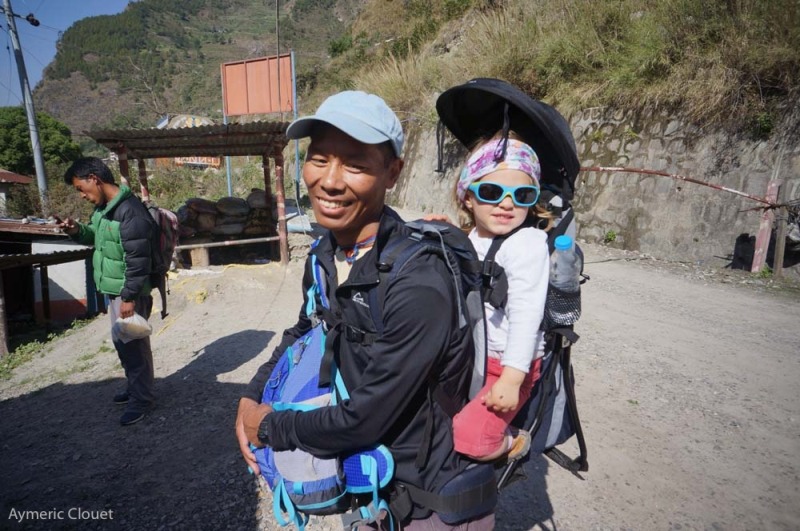
Gualboo, Pinju and Margeaux departing Syabrubesi.
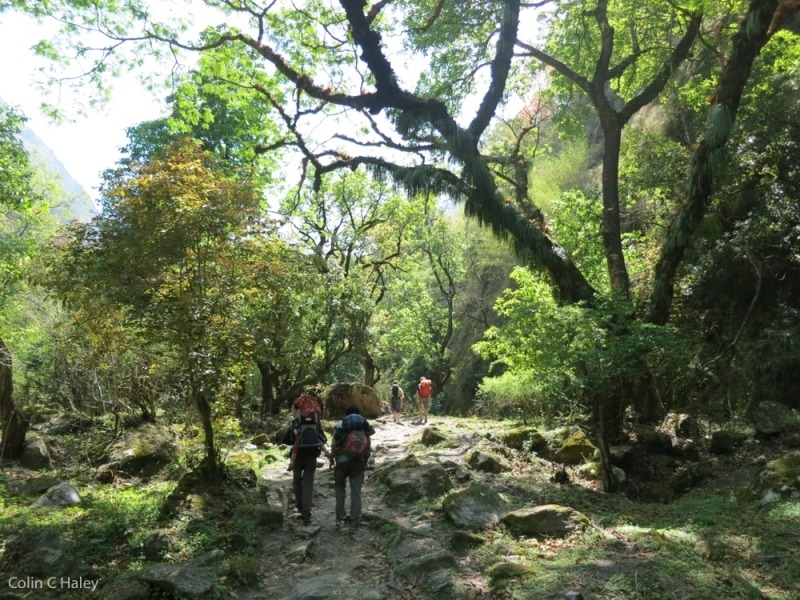
Hiking through lush forest low in the Langtang Valley.
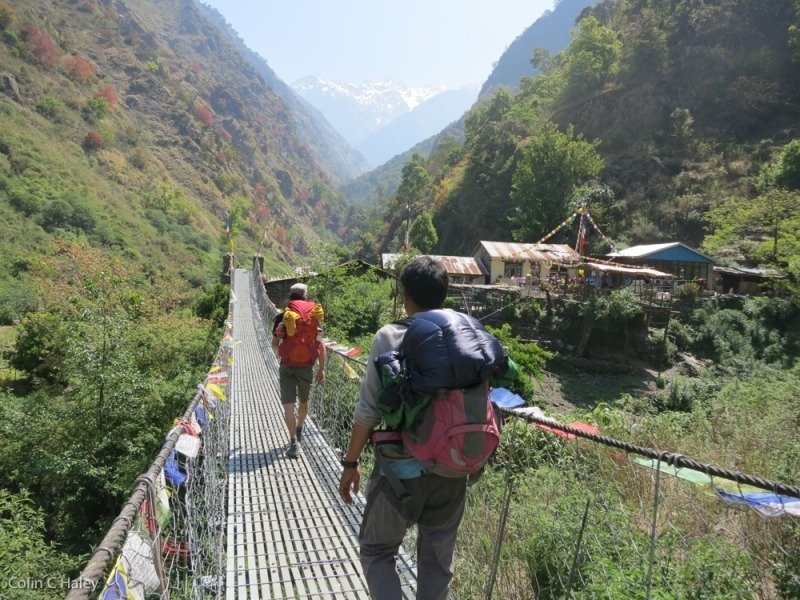
Aymeric and Gualboo crossing one of many very well-built suspension bridges.
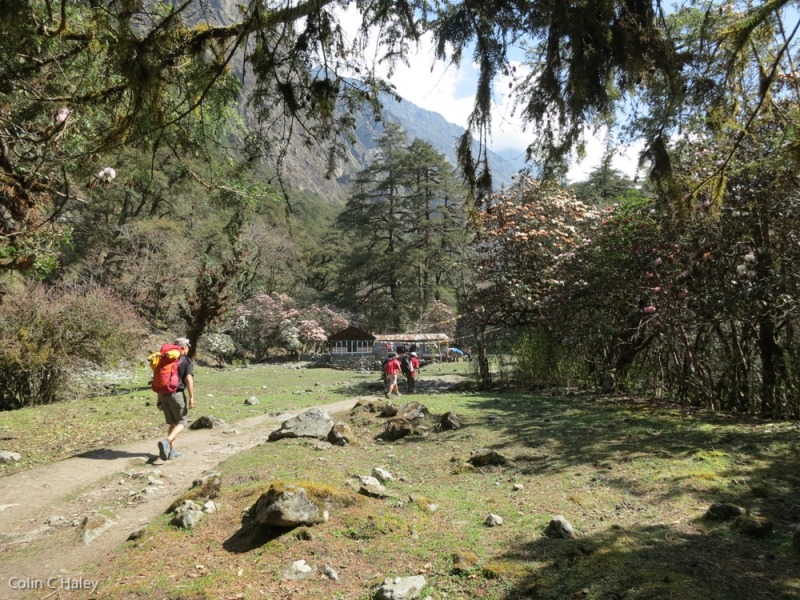
Aymeric entering one of the villages along the way, with rhododendron trees in bloom.
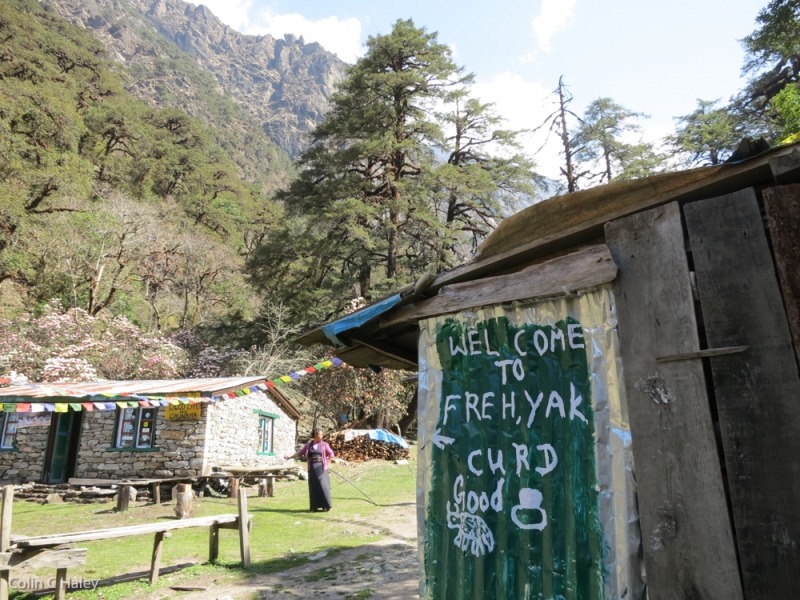
Fresh yak curd, yum!
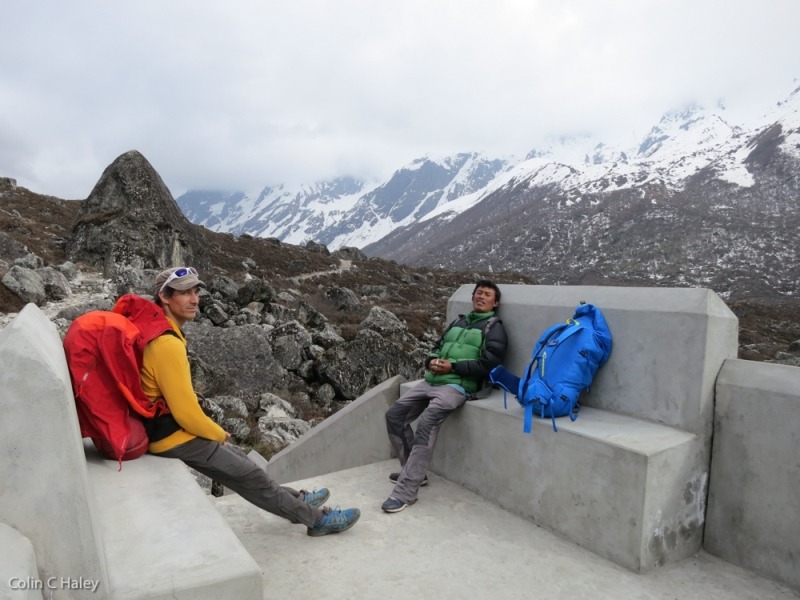
Aymeric and Gualboo taking a breather, almost to Kyanjin Gompa.
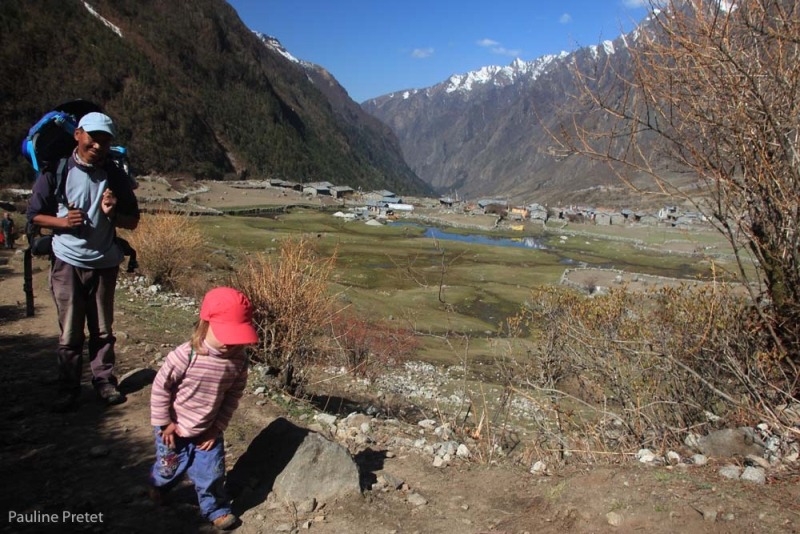
Pinju getting a break, as Margeaux knocks back a section of trail on her own.
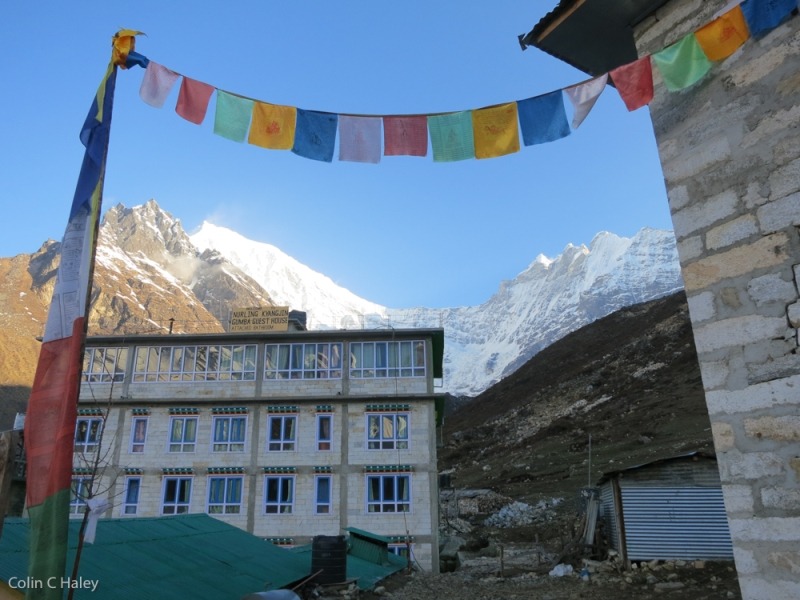
My first morning in Kyanjin Gompa. The building in this photo proved sturdier than all others during the earthquake and avalanche, and afterwards became the de-facto shelter for injured people.
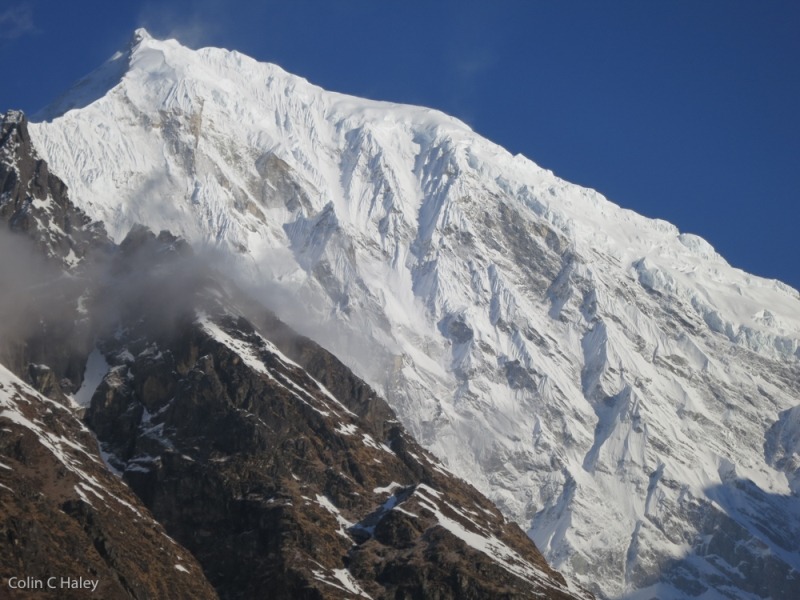
Langtang Lirung (7,200+m), the mountain which caused a devastating avalanche in Kyanjin Gompa and a massively deadly avalanche in Langtang Village.
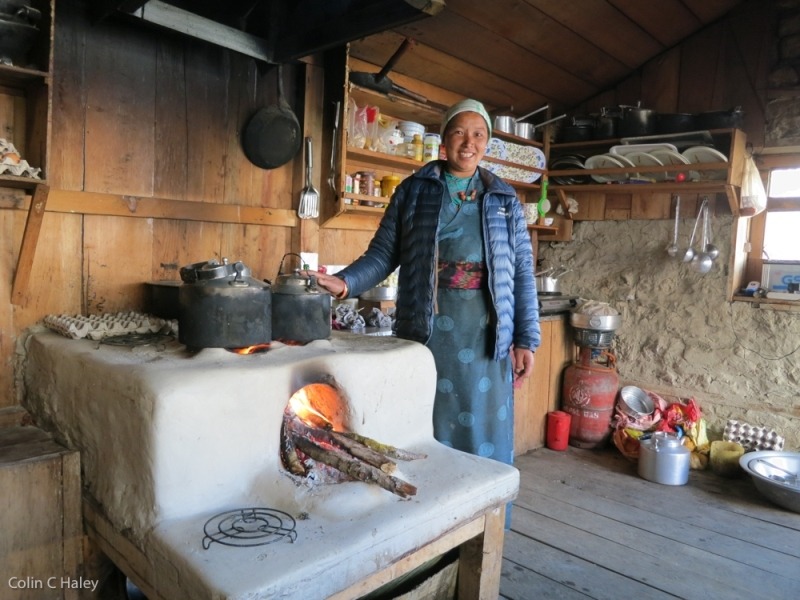
Lopsang in her kitchen.
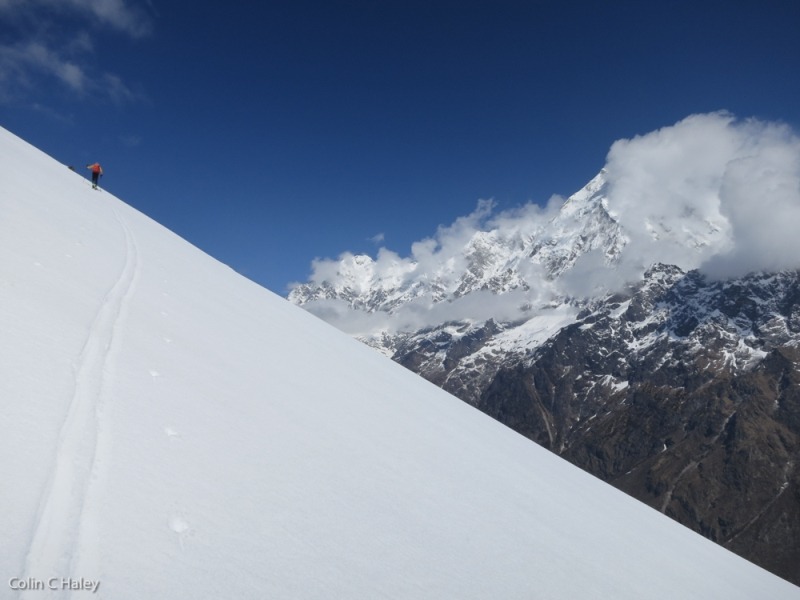
Aymeric skinning on our first ski day, with Langtang Lirung behind, but on the opposite side of the valley.
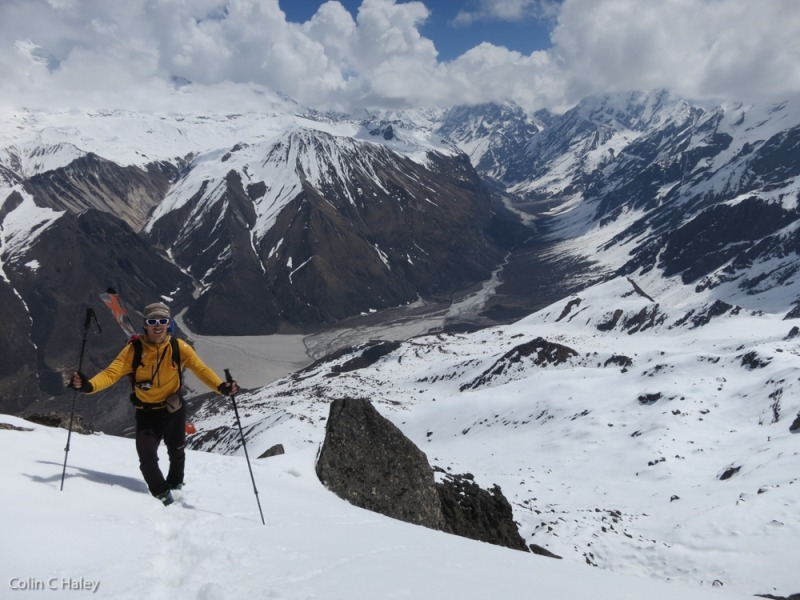
Aymeric near the top of our little 4,900m sub-summit.
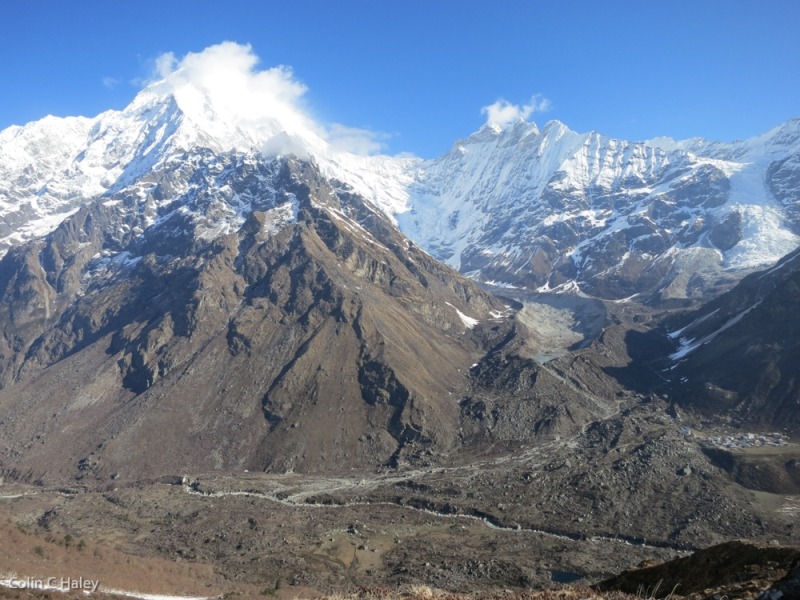
A view of Langtang Lirung from the south-southwest. The slopes on the far left side of the photo are where the deadly avalanche that hit Langtang Village originated. The slopes on the right side of Langtang Lirung (and the peaks to the right) avalanched towards Kyanjin Gompa, which is visible in the lower right of the photo. I think the debris of the avalanche stopped inside the moraine, where the small lake is visible. Next to Kyanjin Gompa you can see part of the grassy plateau that I was blown off of, and the hill below the village on which I landed partway down.
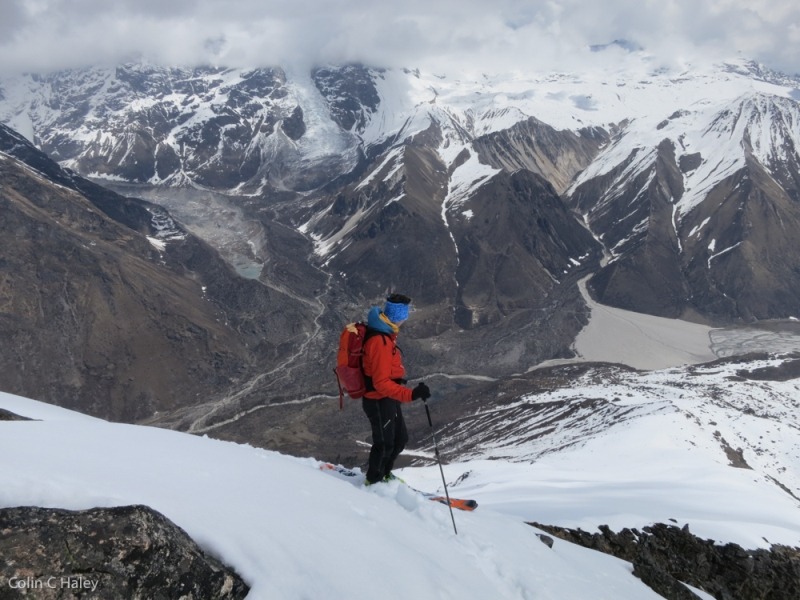
Aymeric ready to ski down.
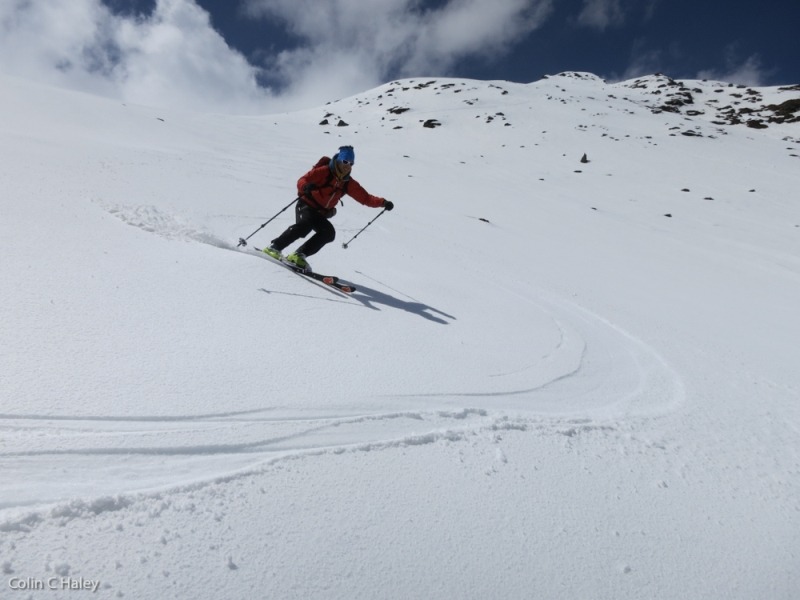
Aymeric enjoying some nice spring skiing in the Himalaya!
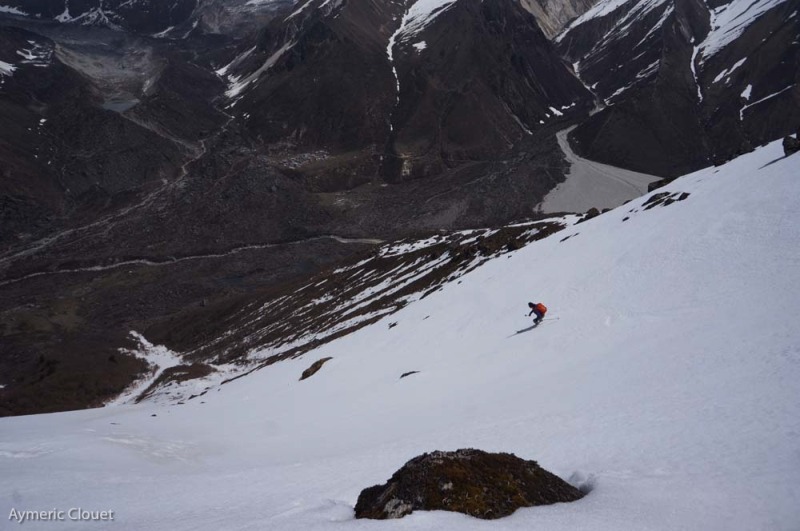
Colin descending back down to the valley
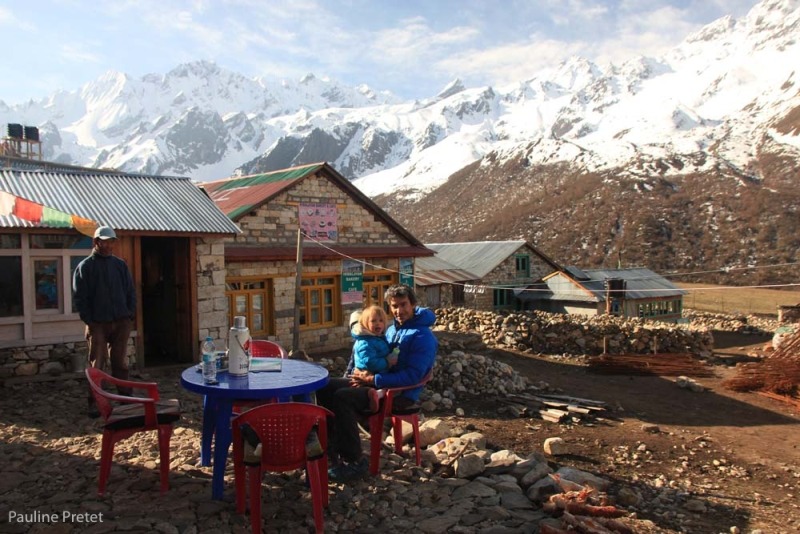
Pinju, Aymeric and Margeaux enjoying a sunny morning at Gualboo’s guesthouse.
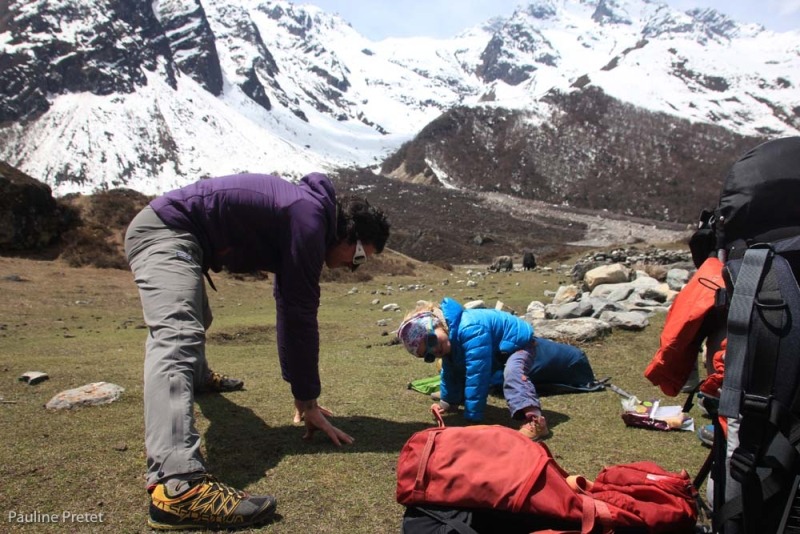
Colin and Margeaux doing some group stretching.
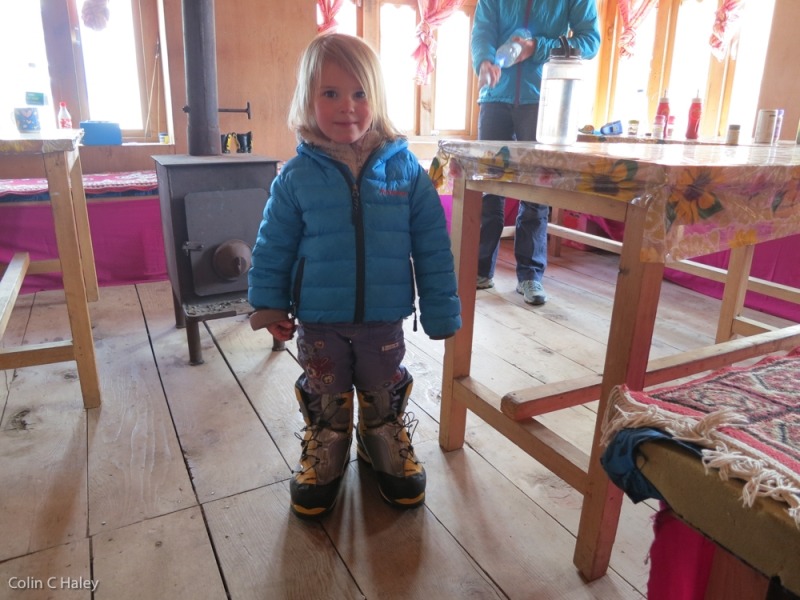
Margeaux trying out some new footwear in the “dining room” of Gualboo’s lodge.
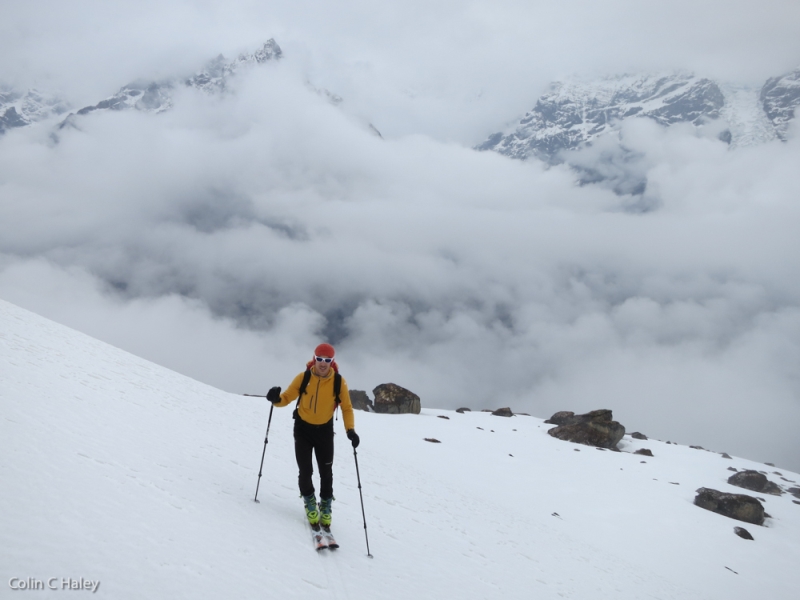
Aymeric skinning up the south side of the valley, above Kyanjin Gompa, early on the morning of April 25. The clouds socked in shortly after I took this photo, causing us to abandon our skiing plans for the day and head back to the village. Had the skies been clear we would’ve almost certainly died in an avalanche, as essentially any slope that could ever avalanche did so in a cataclysmic way.
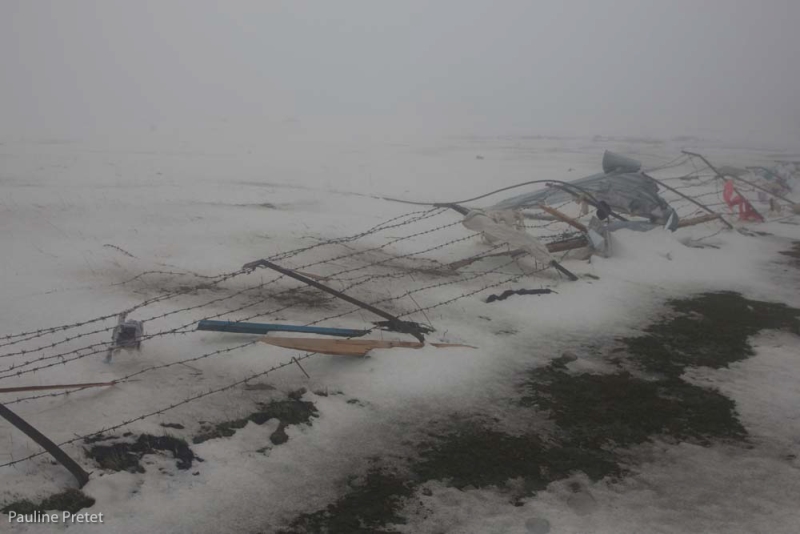
A barb-wire fence flattened to the ground by the wind blast of the avalanche.
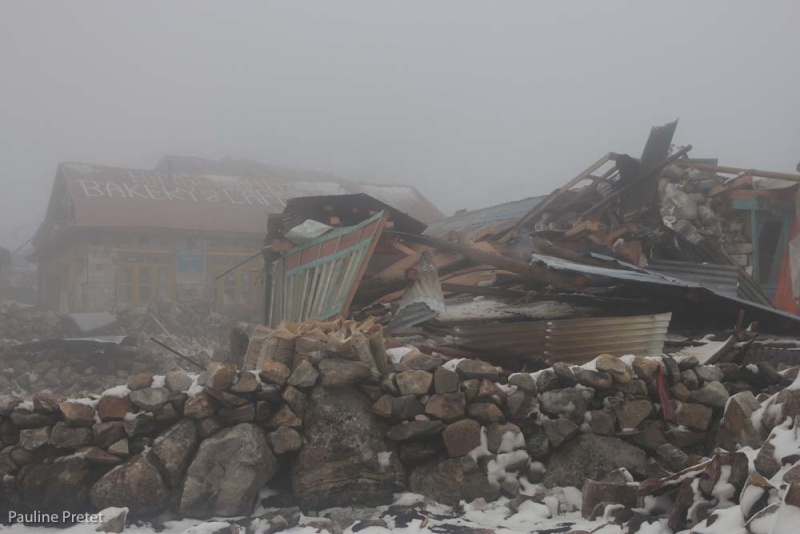
Destruction.
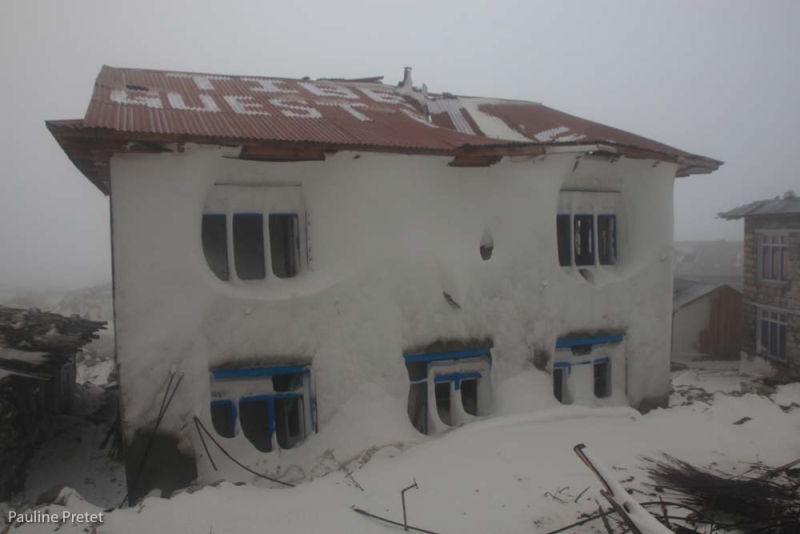
This photo helps give a sense of the fact that a lot of snow hit Kyanjin Gompa, even though it was “just” the powder cloud.
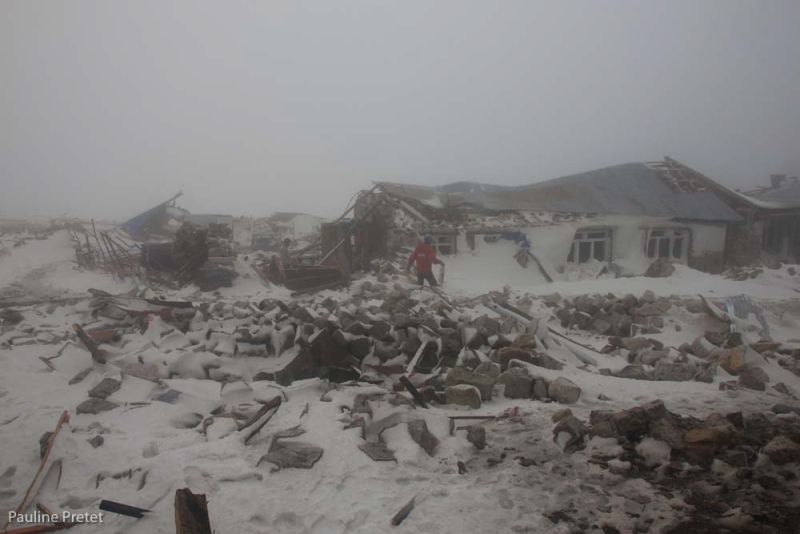
Pinju amidst the wreckage.
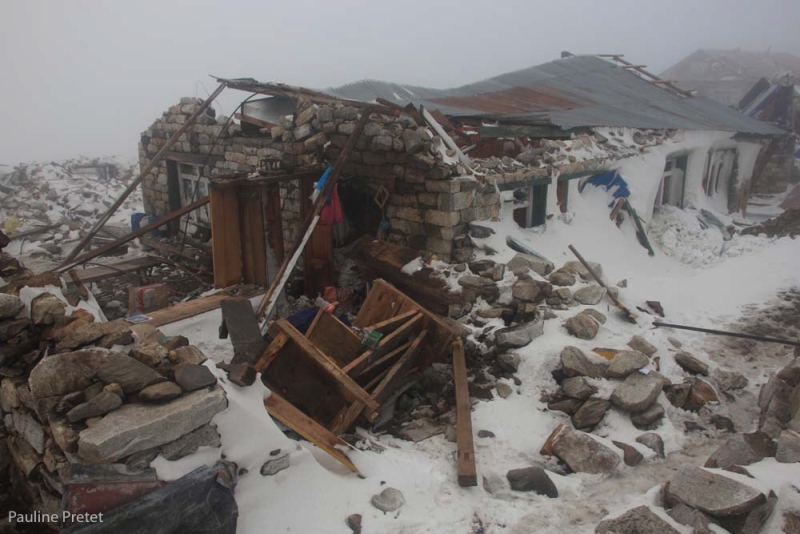
Destruction.
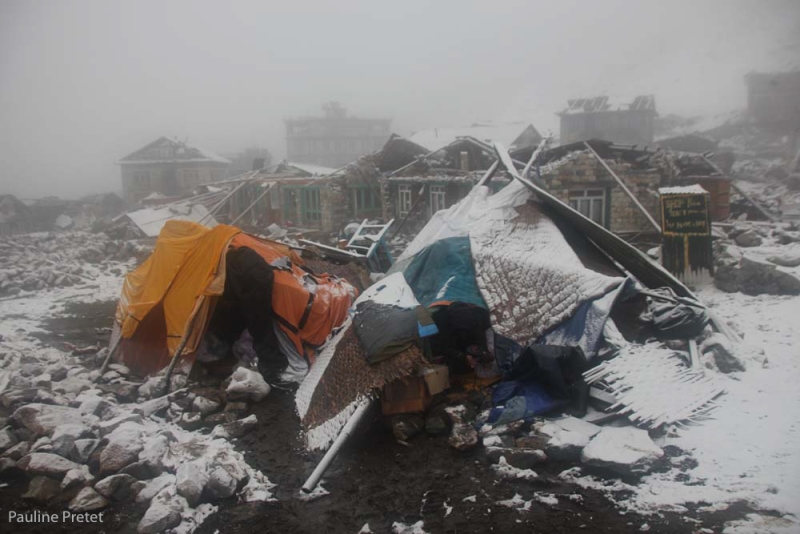
This is the bivouac shelter where we spent our first night after the avalanche, with some other foreigners in the shelter to the left.
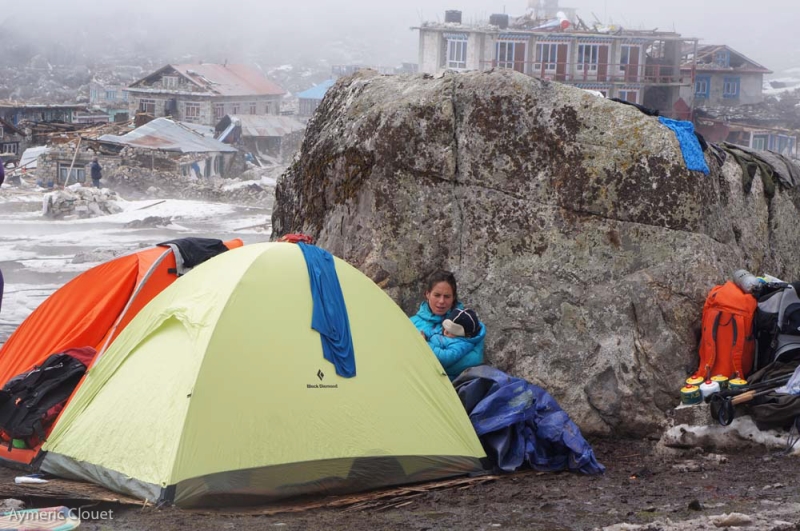
Pauline and Margeaux at our second camp, on the downhill side of a boulder in the grassy field.
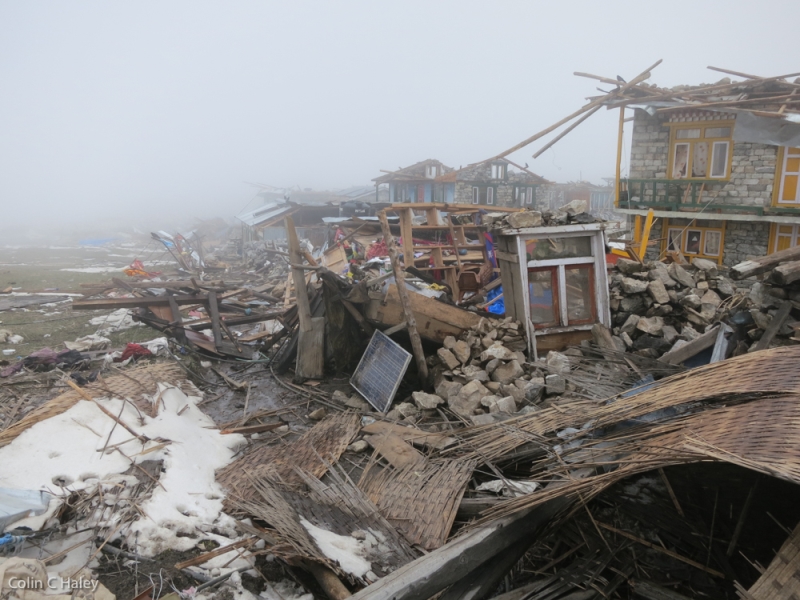
Destruction.
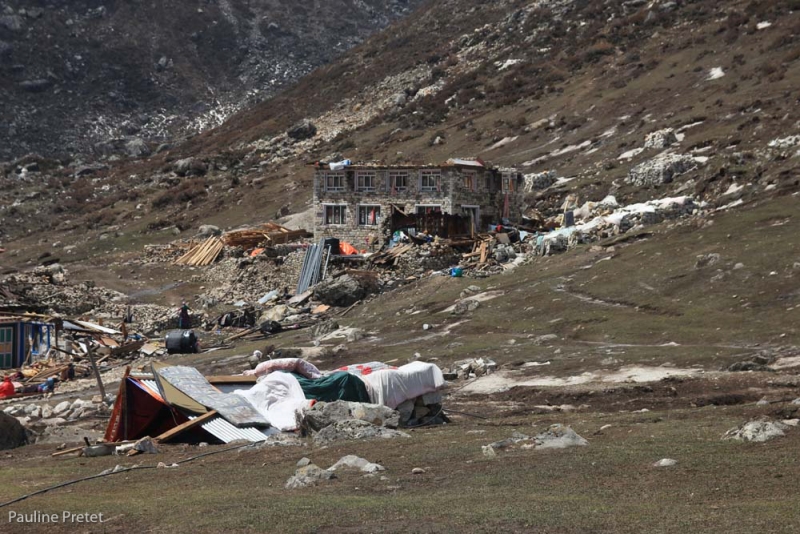
Another makeshift camp in the grassy field, where some non-local Nepali were staying.
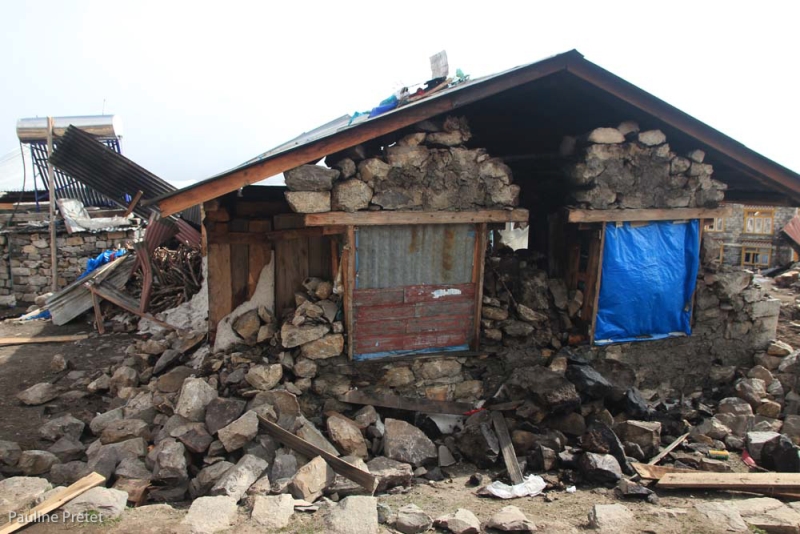
Destruction.
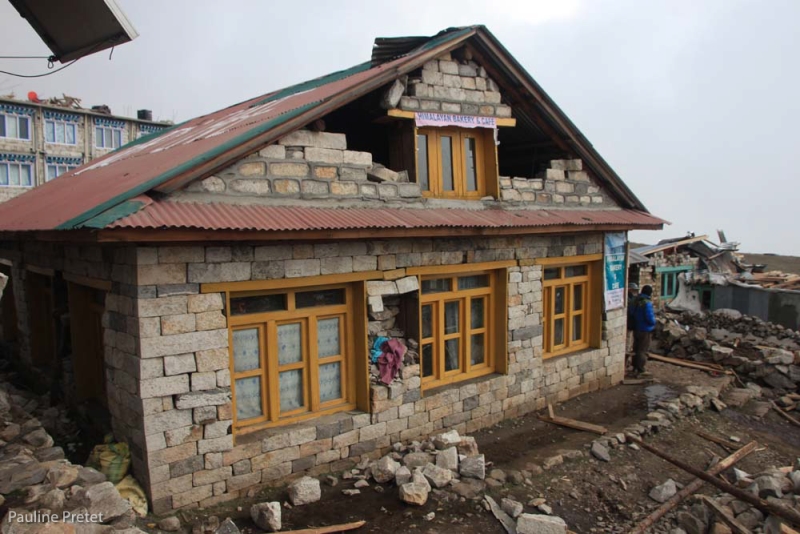
Destruction.
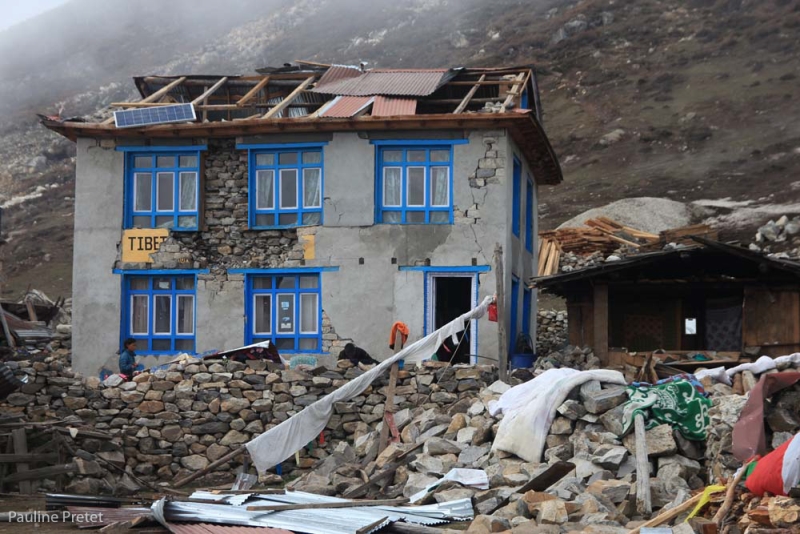
Destruction.
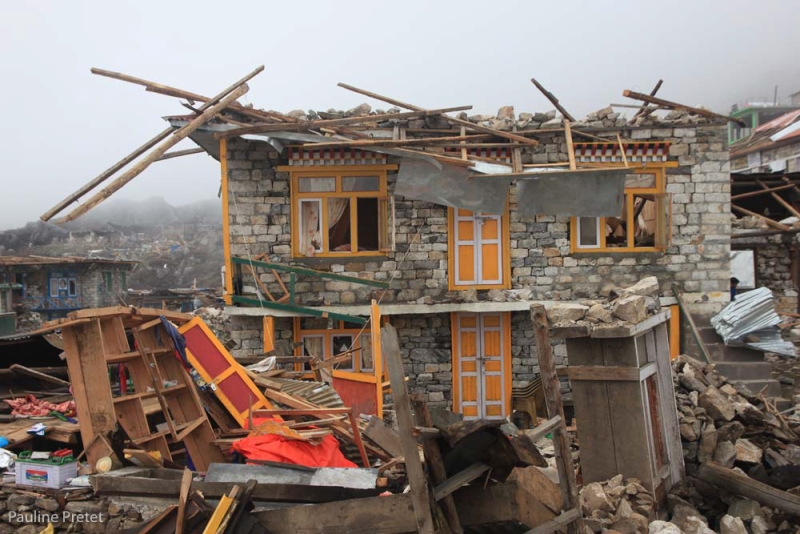
Destruction.
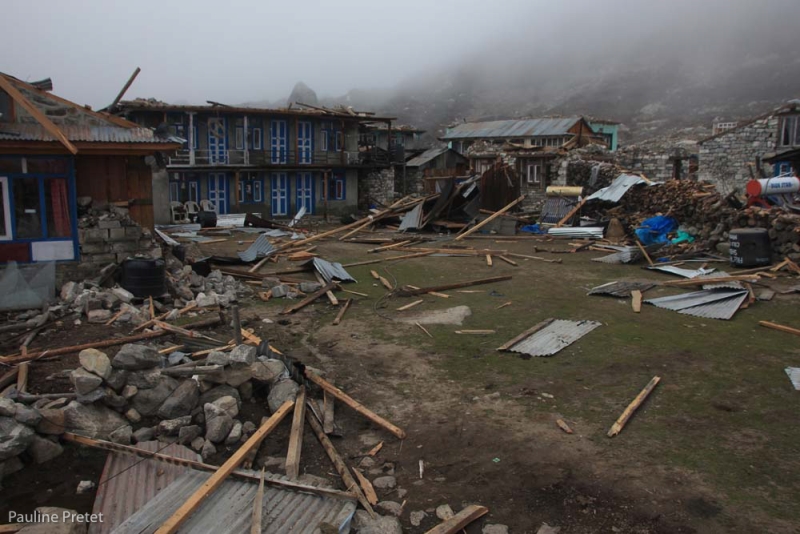
Destruction.
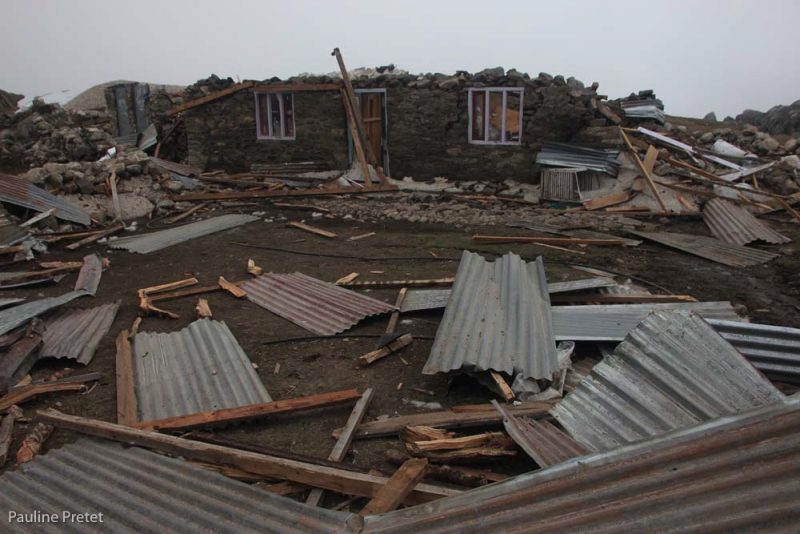
Destruction.
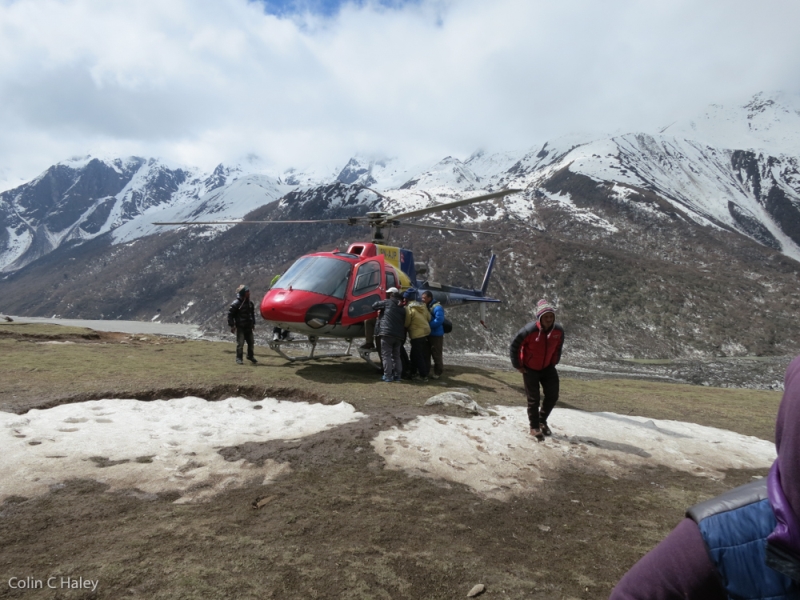
Injured people being loaded into a helicopter.
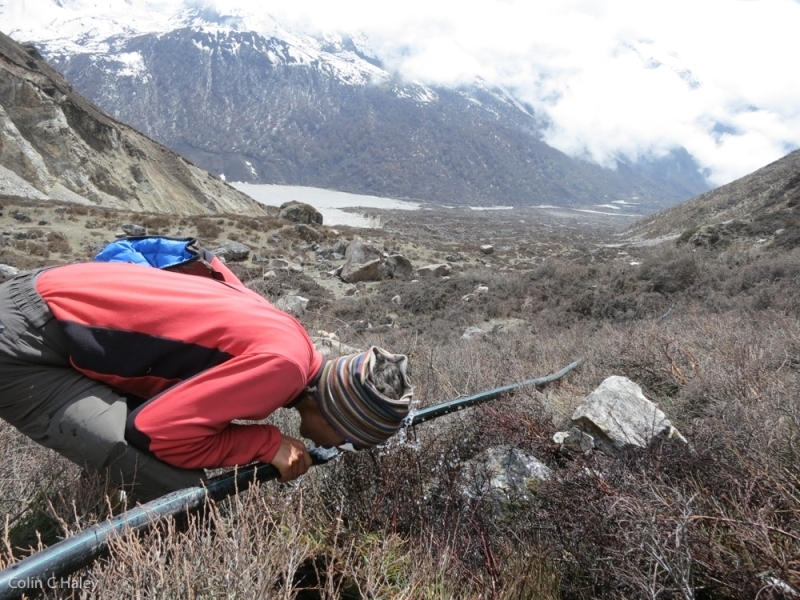
Aymeric sipping some water out of the leaking pipe, during our mission to fix the water supply.
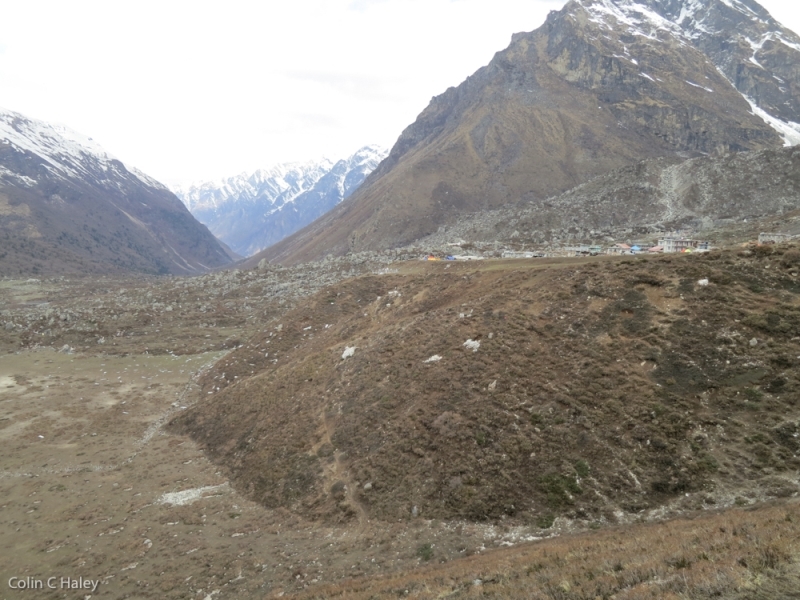
A view of Kyanjin Gompa from just to the east. The grassy meadow plateau is visible in the foreground of the town, as is the hill on which I landed, and the valley floor where I came to a stop.
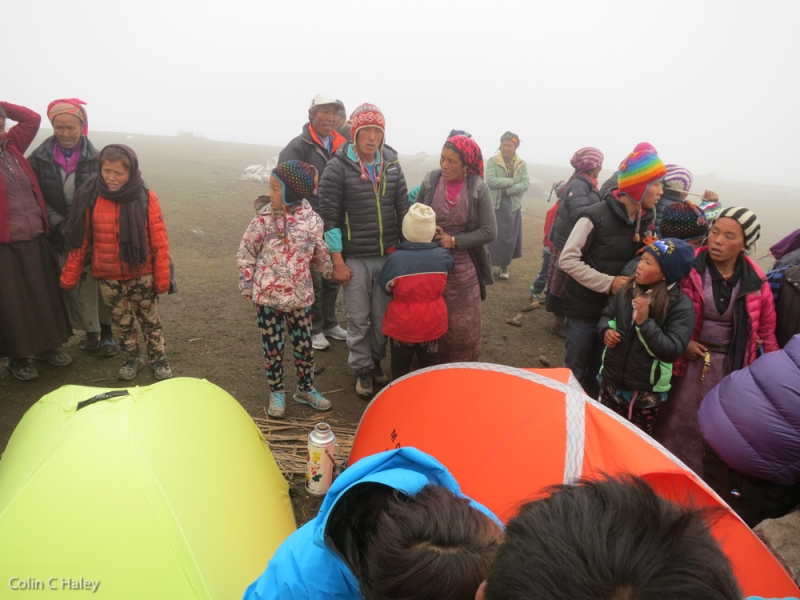
People huddling around the boulder during an aftershock.
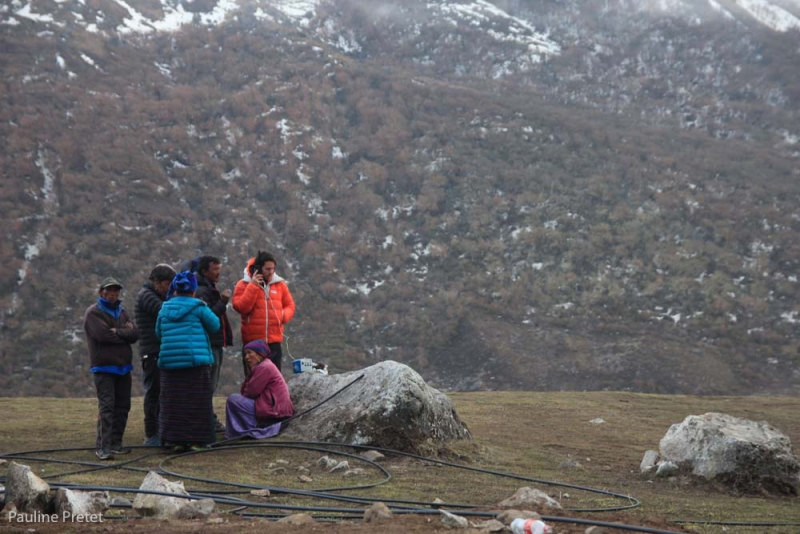
Colin playing phone booth.
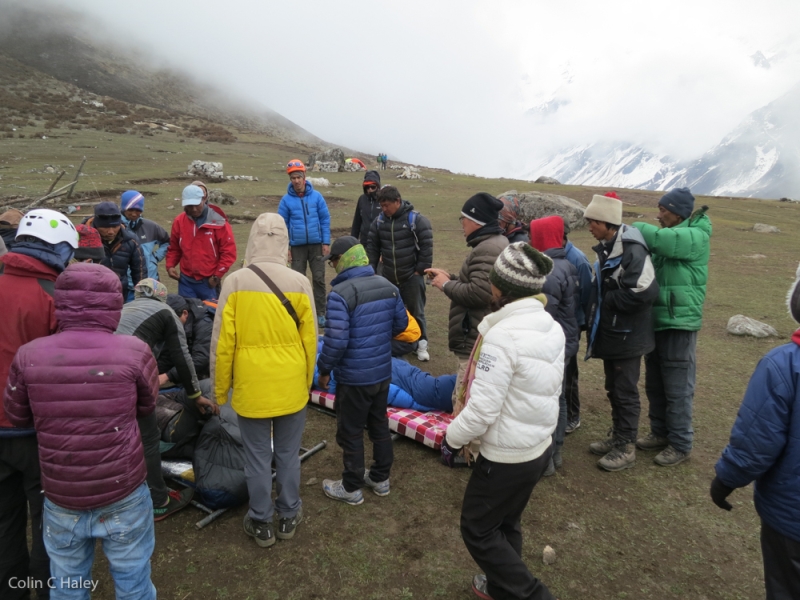
Injured people ready to be loaded onto the next helicopter.
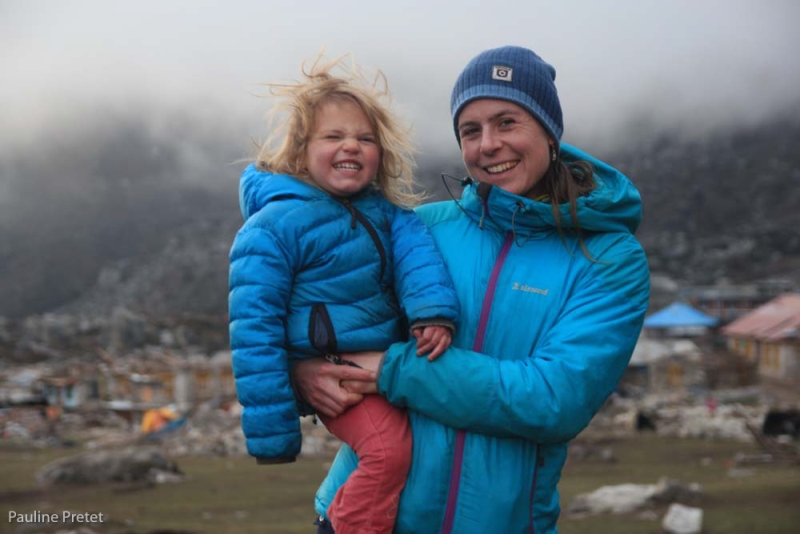
Margeaux and Pauline enjoying a lighter moment.
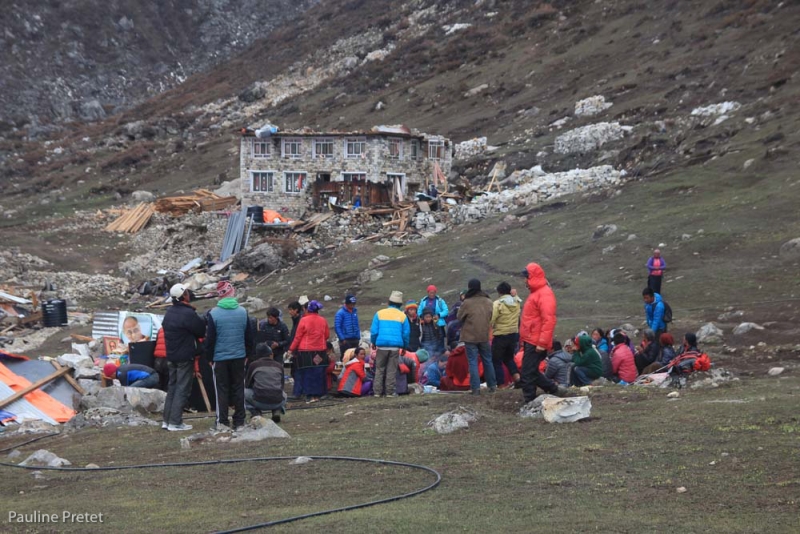
A group of Nepali, most of whom had been living down-valley, and came up to Kyanjin Gompa seeking a safer refuge.
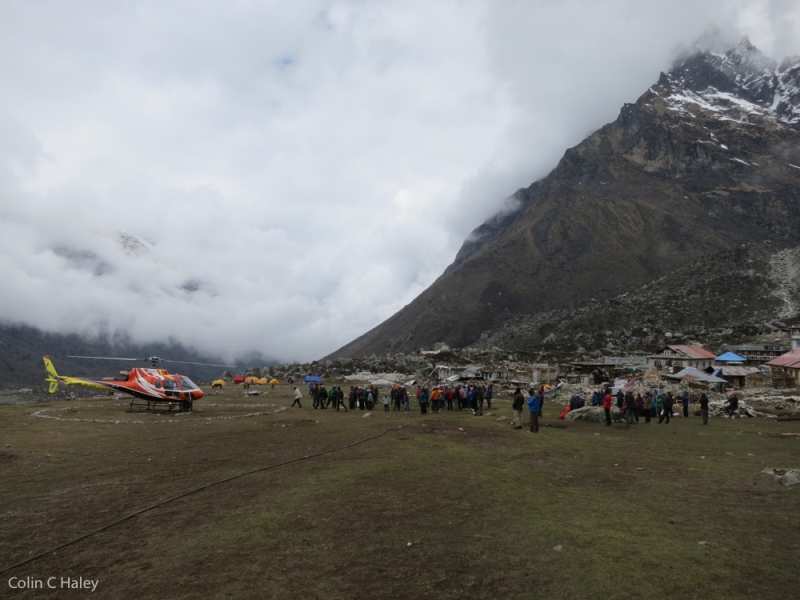
Another helicopter evacuation.
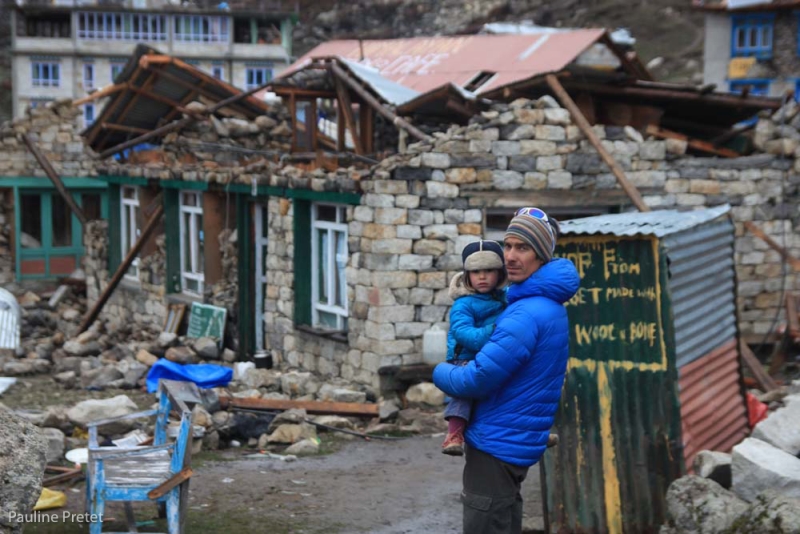
Aymeric and Margeaux walking through town.
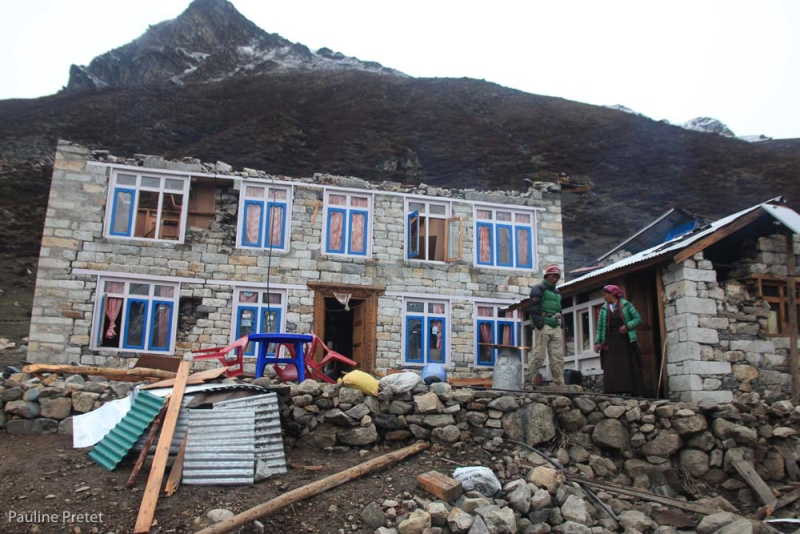
Gualboo and Lopsang in front of their seriously damaged lodge.
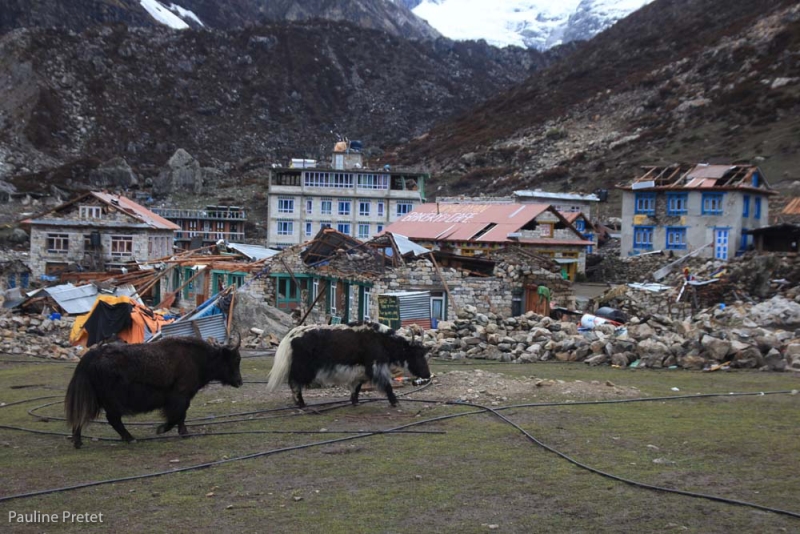
Yaks returning to the village.
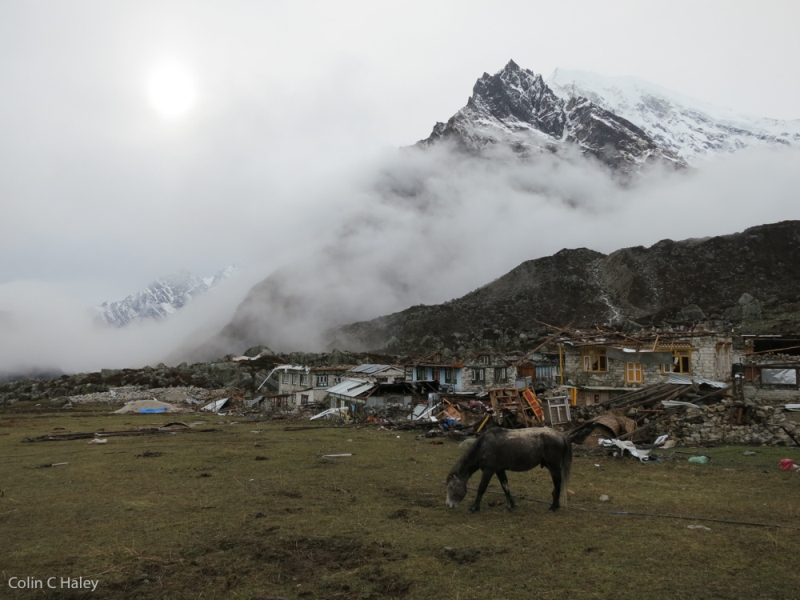
A horse returned to the village.
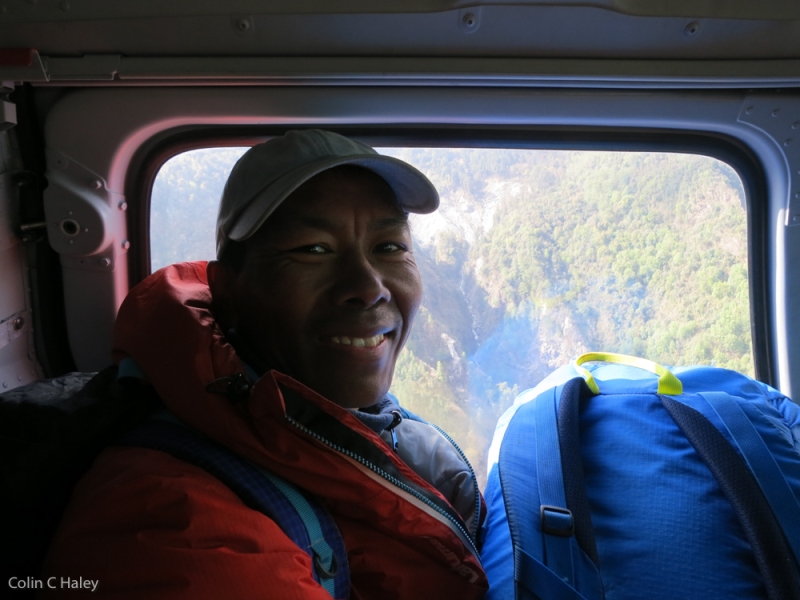
Pinju happy to on a helicopter out of Kyanjin Gompa.
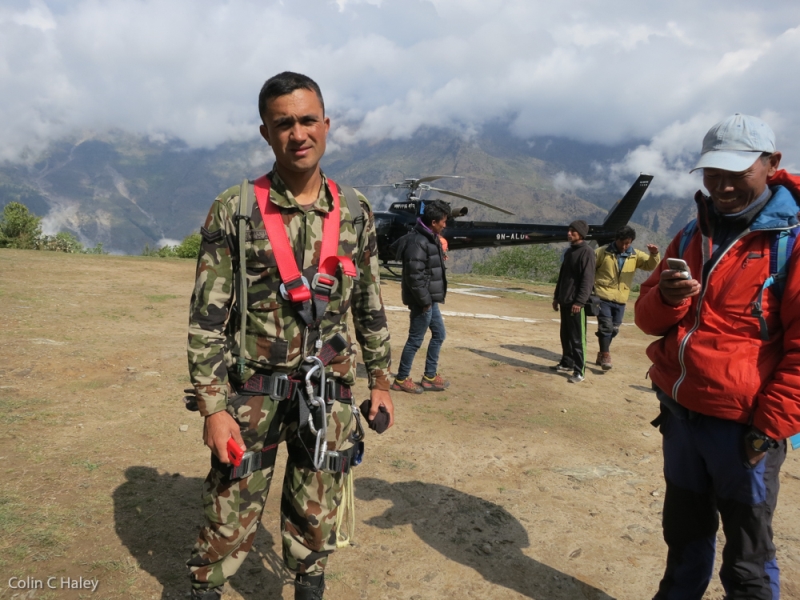
Nepali army and Pinju upon arrival in Dhunche.
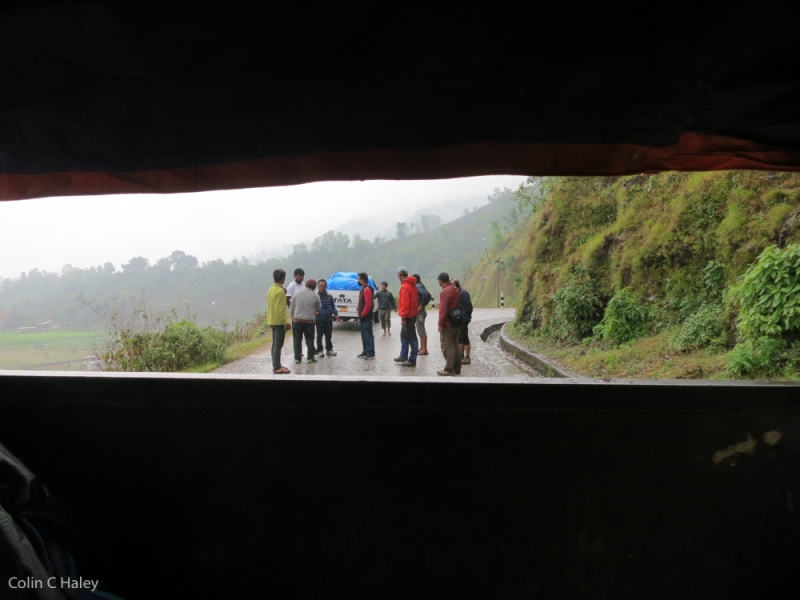
During our drive from Kalikasthan to Kathmandu, some of our group got out to discuss whose fault the destroyed side view mirror was (the first time).
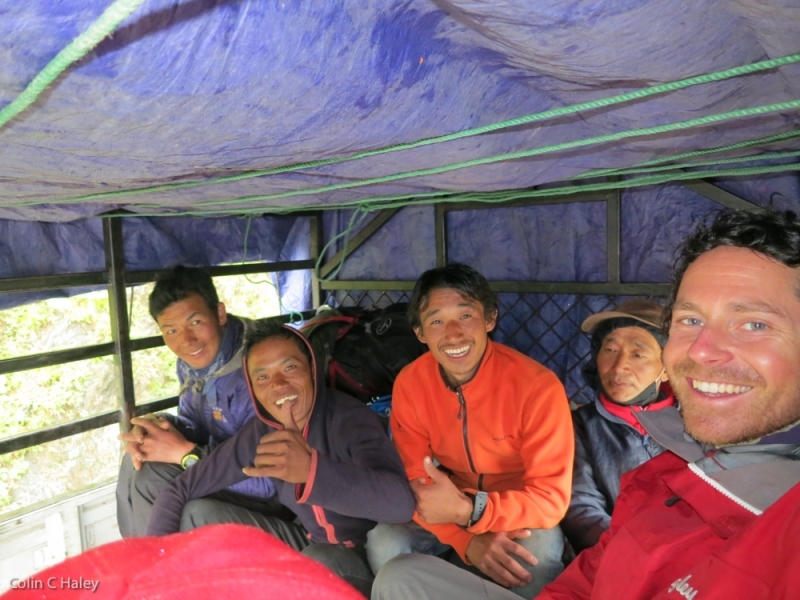
The rest of us stayed out of it! I really enjoyed hanging out with these guys on our journey from Dhunche to Kathmandu.
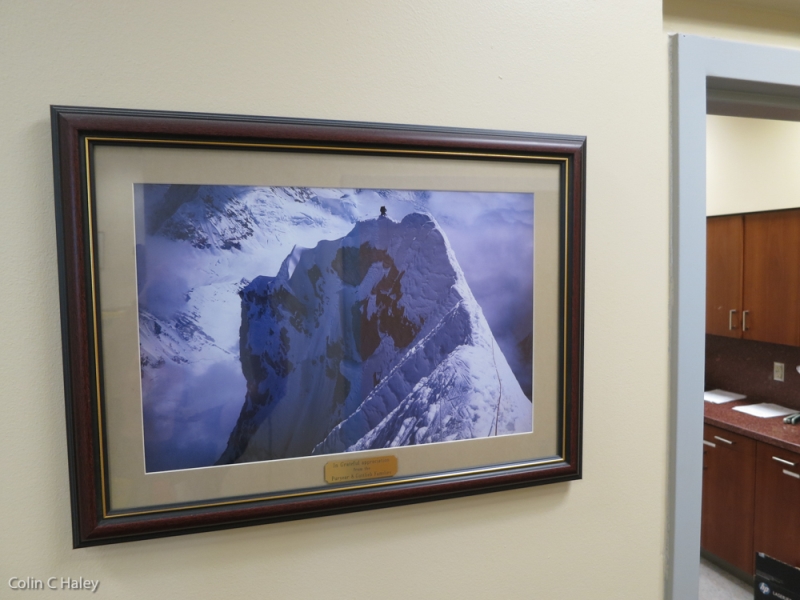
Joe Puryear’s photo of Mark Westman on the Infinite Spur, on the wall of the US embassy in Kathmandu.
How You Can Help
Waves for Water have been on the ground in Nepal since shortly after the earthquake hit distributing their low-cost but highly effective water filtration systems to those most in need. Your donation will help them continue this important relief work.
Learn more and donate to Waves for Water
We recommend supporting Waves for Water, but if you’d rather donate elsewhere, The New York Times compiled a list of charities working on earthquake relief in Nepal. Thank you for helping.
